
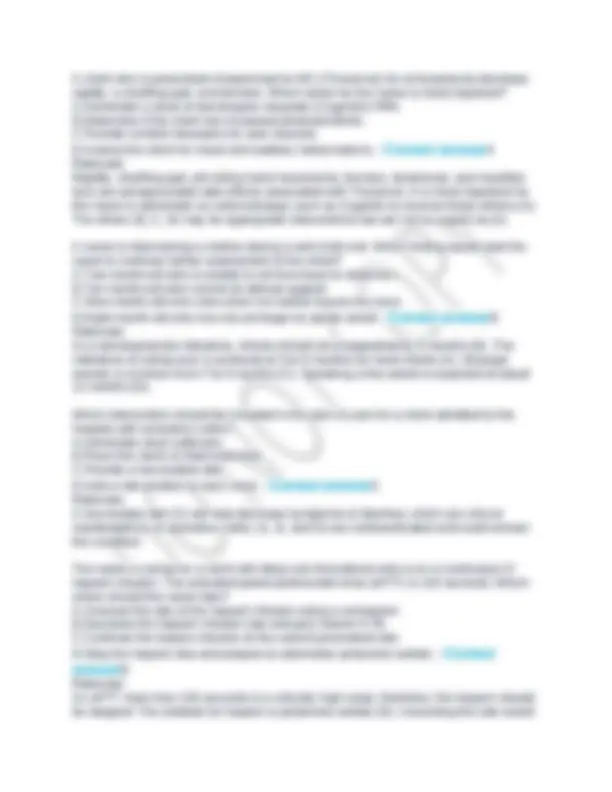
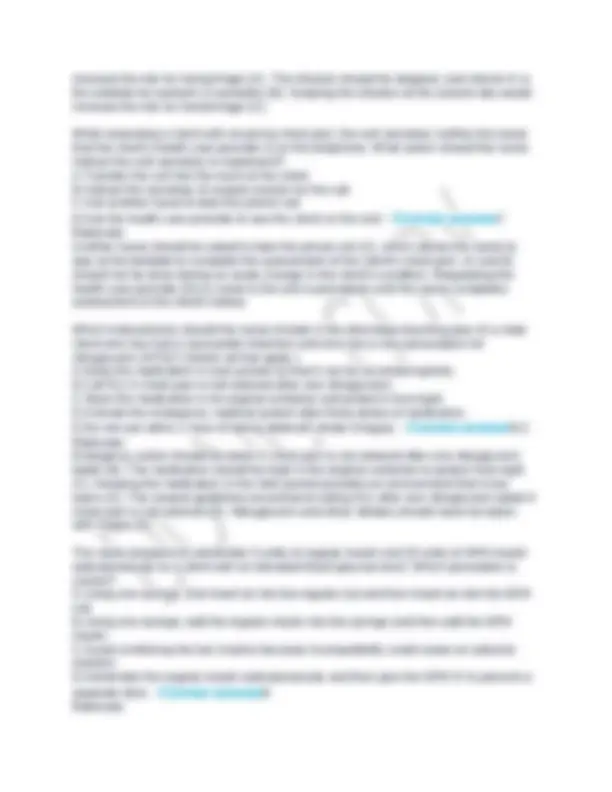
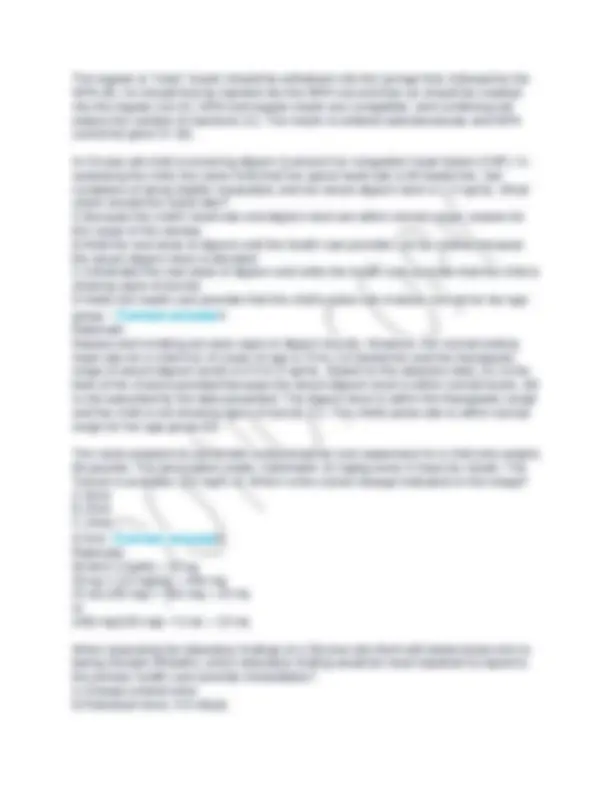
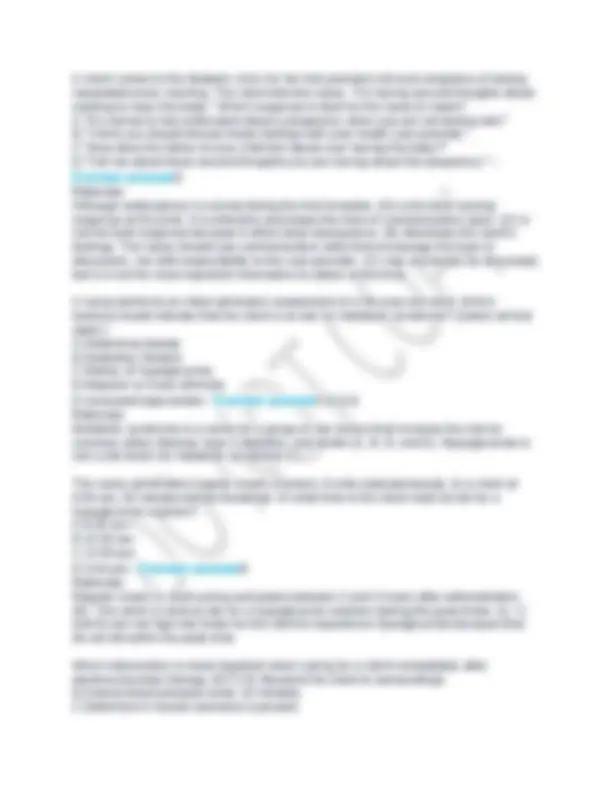
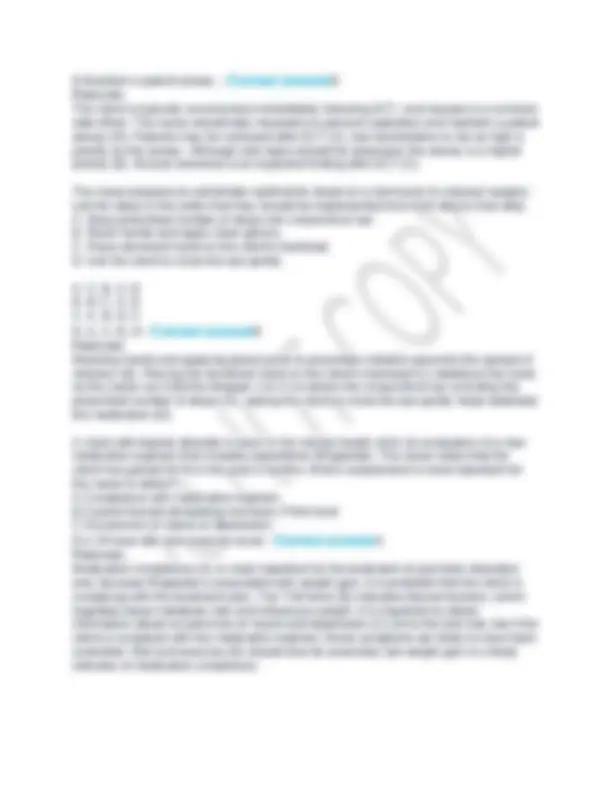
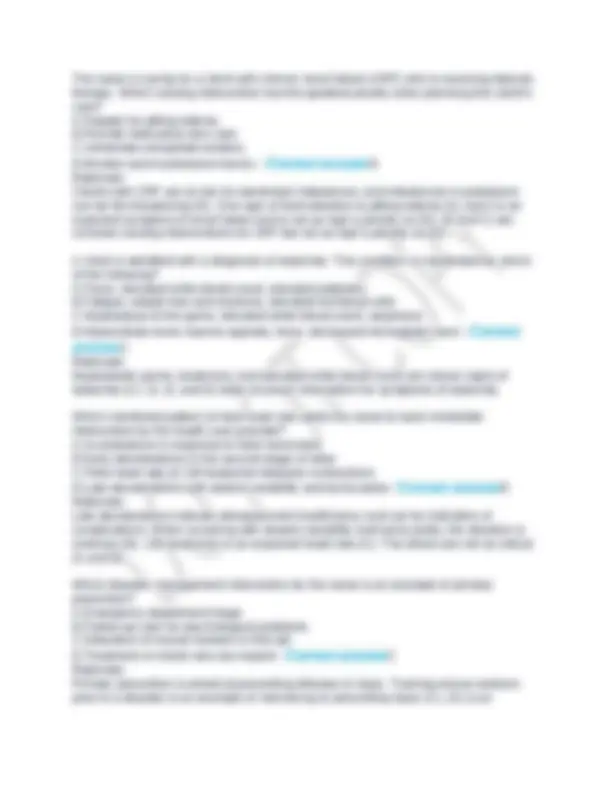
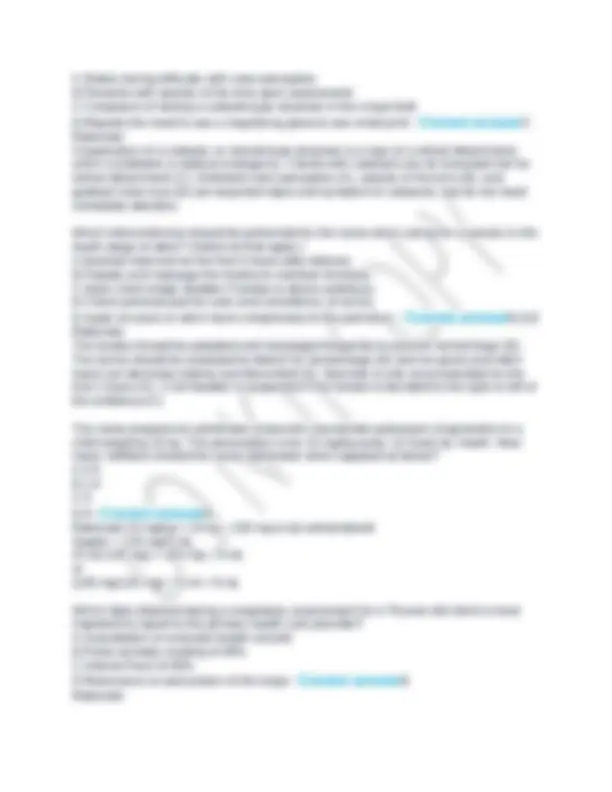
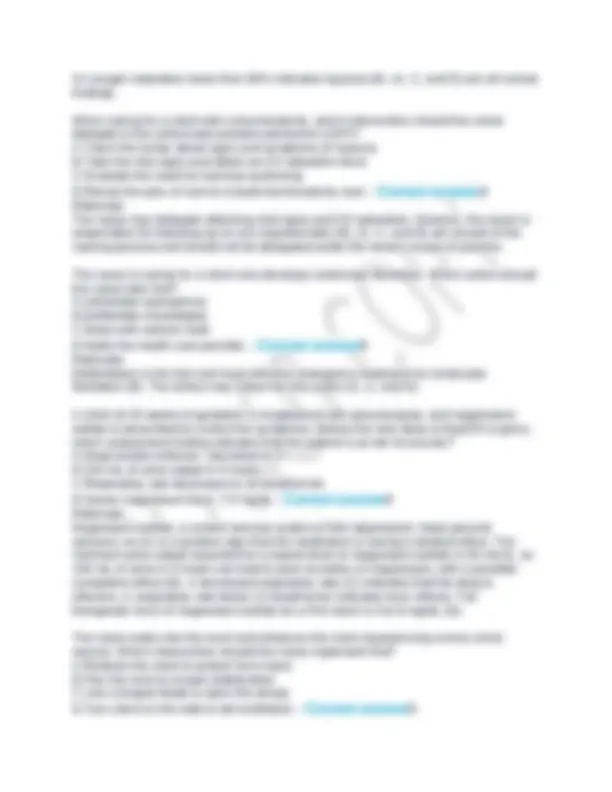
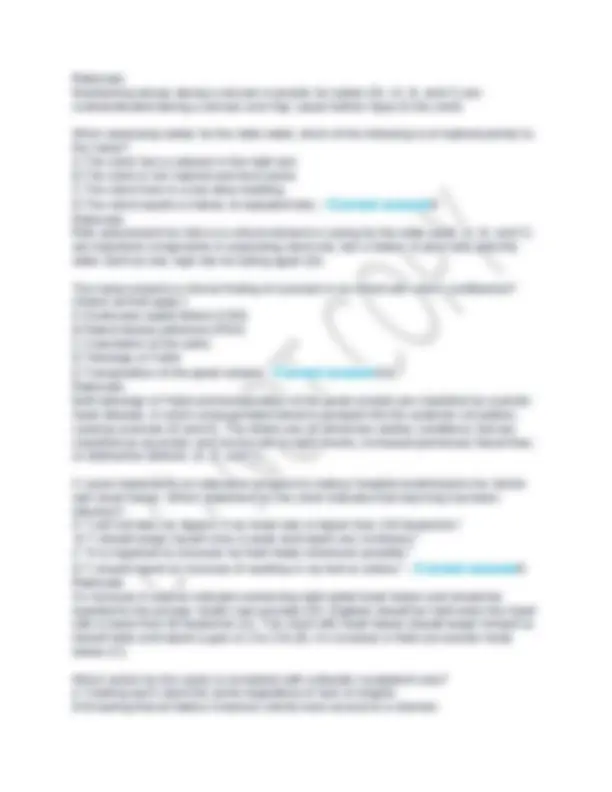
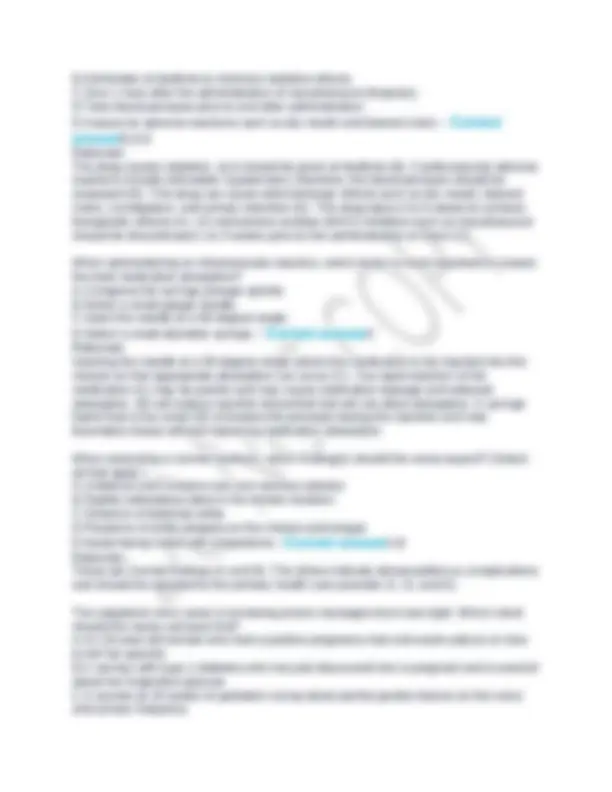
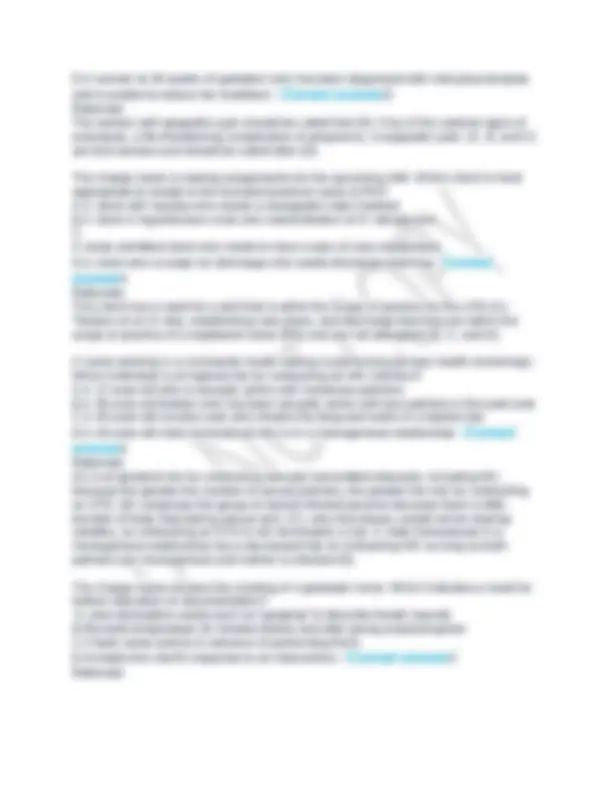
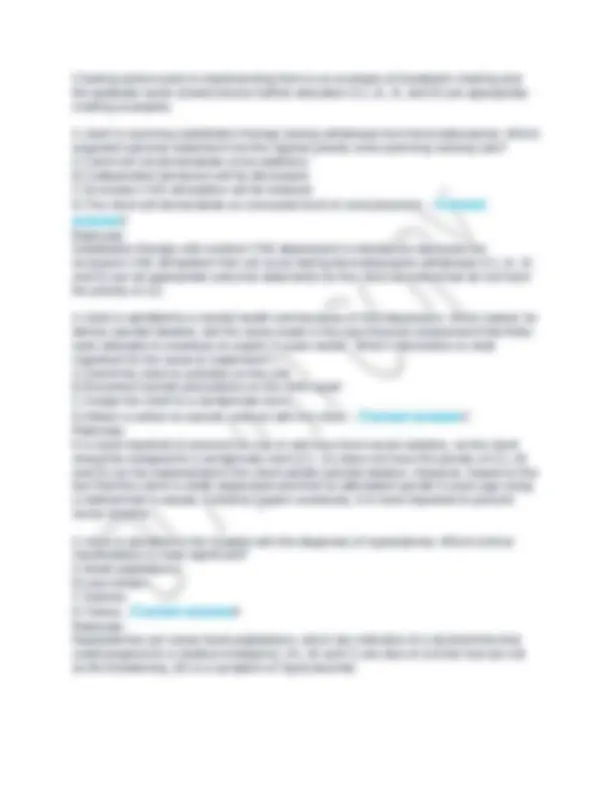
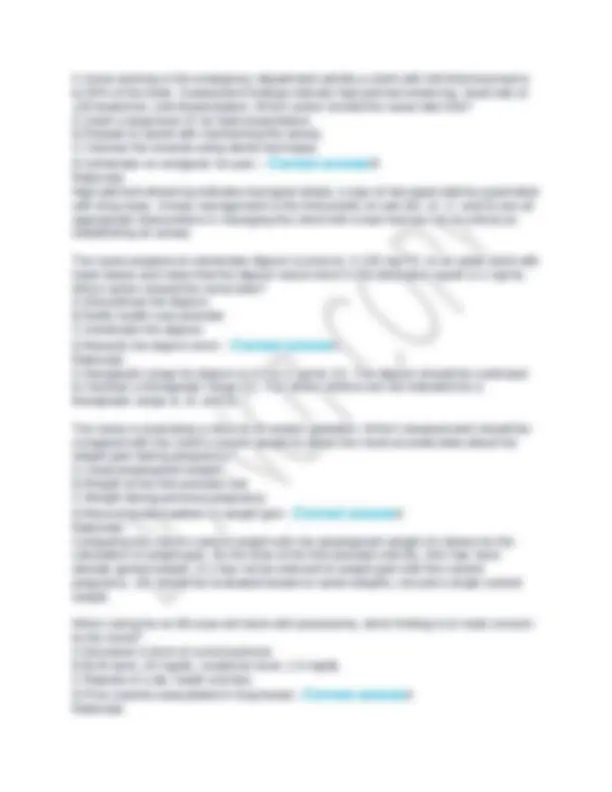
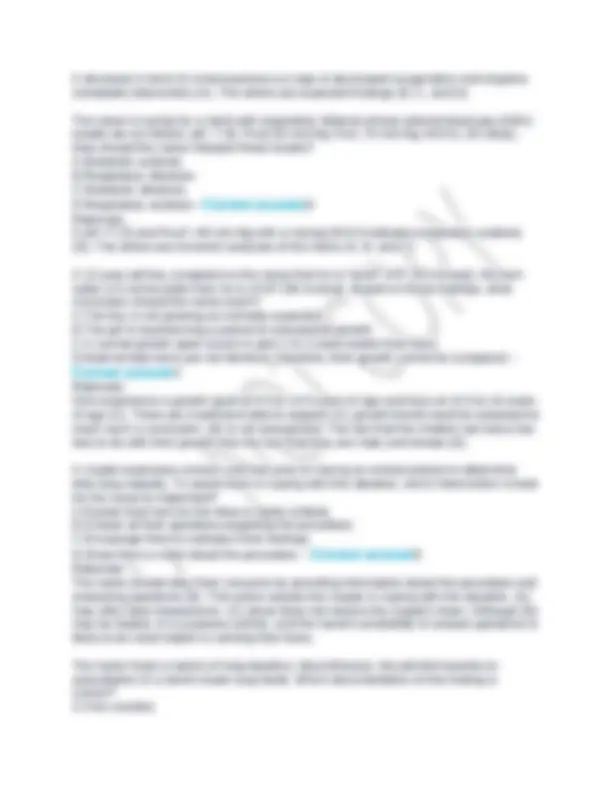
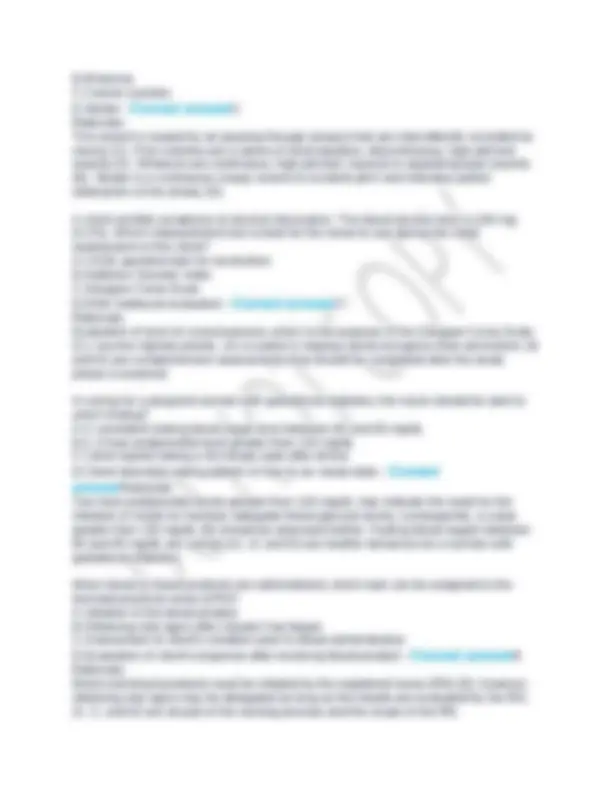
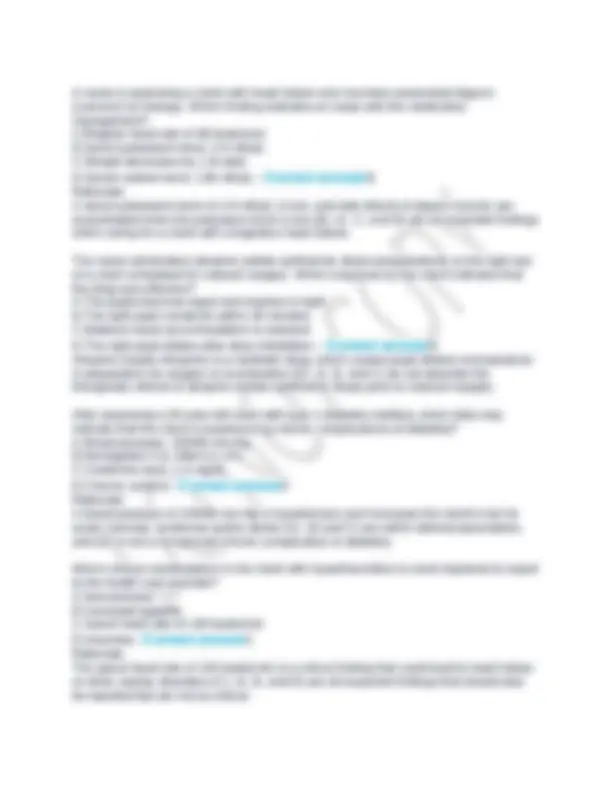
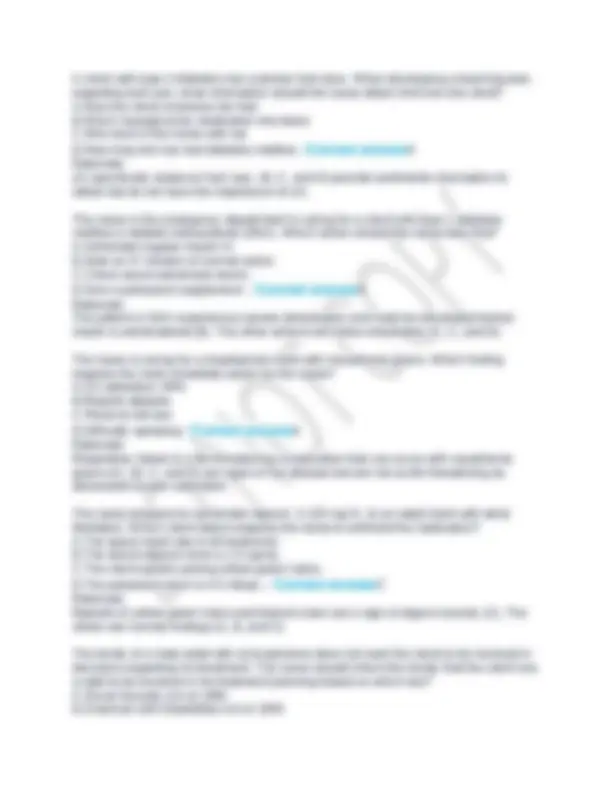
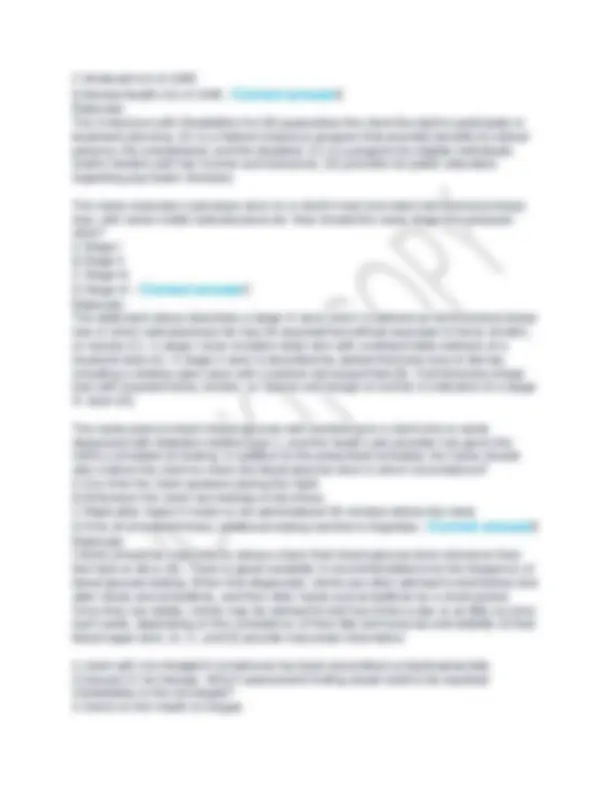

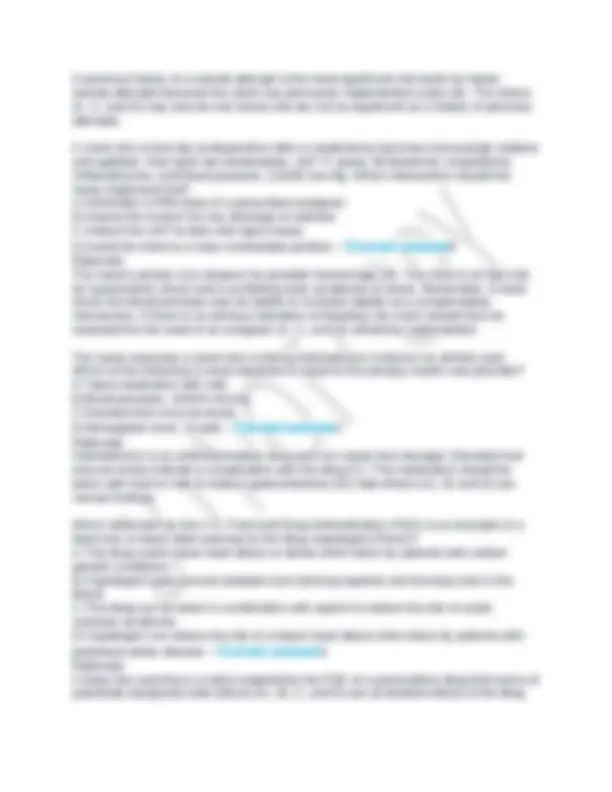
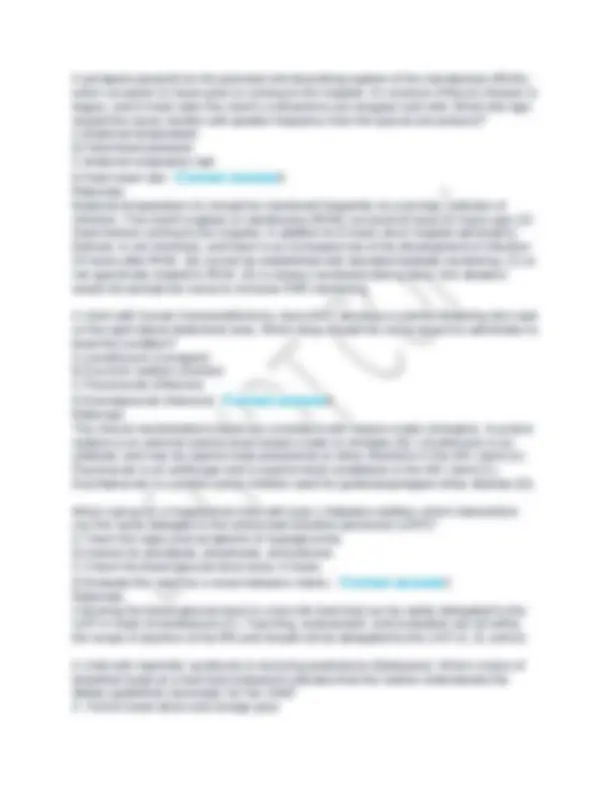
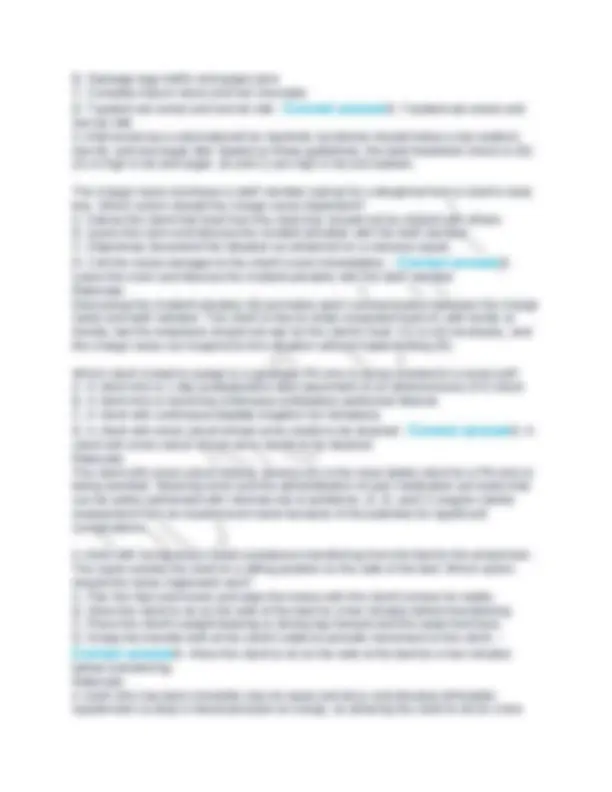
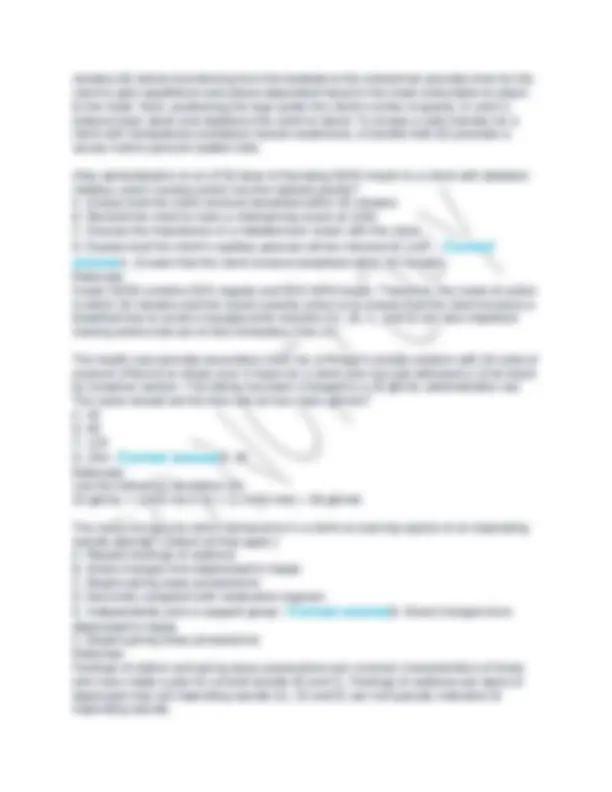
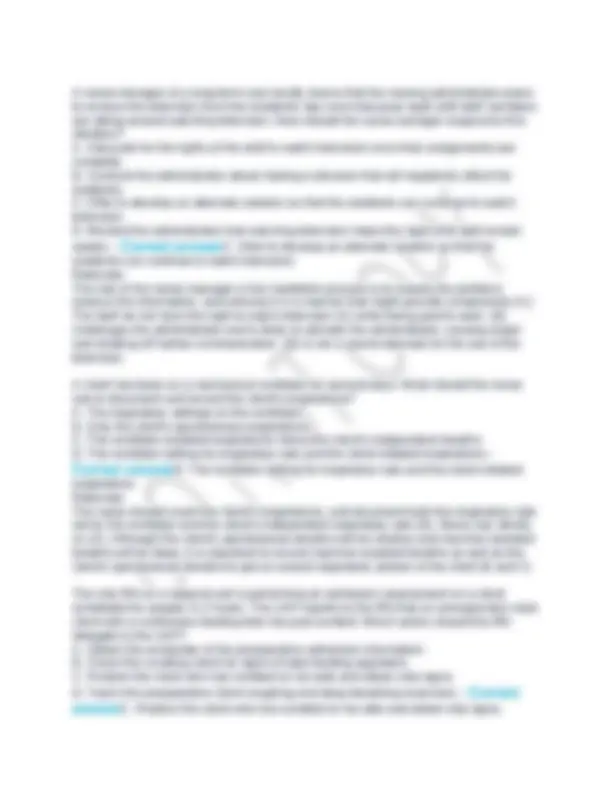
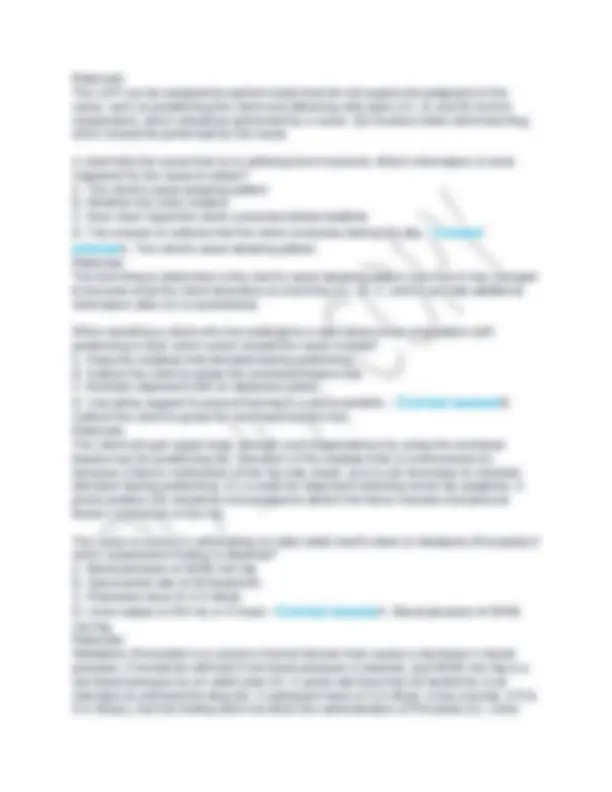
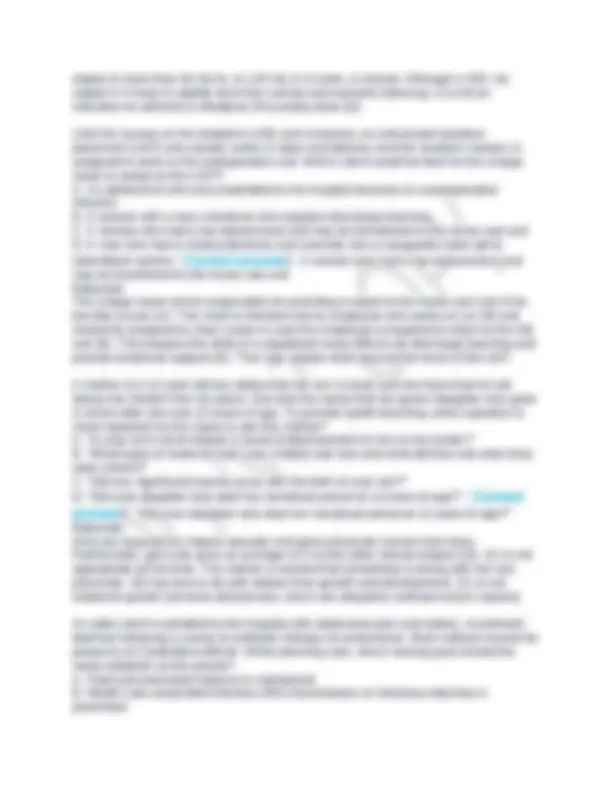
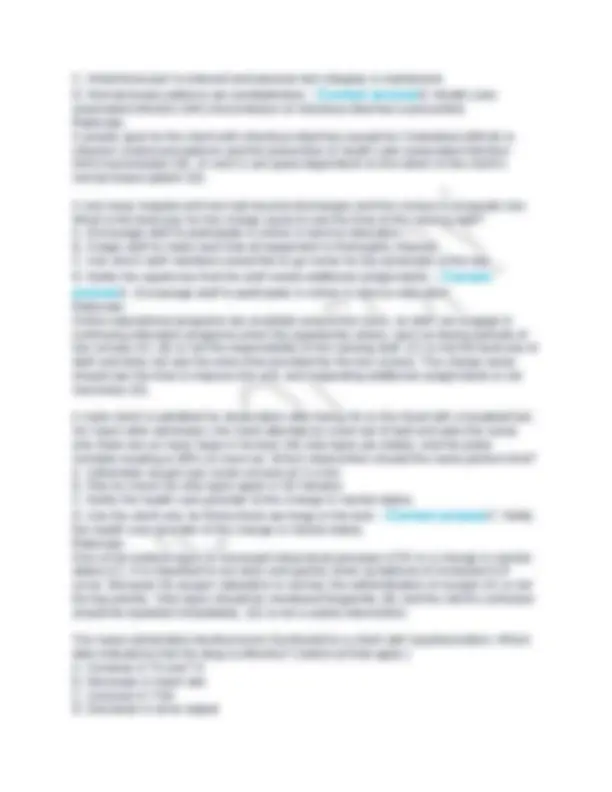
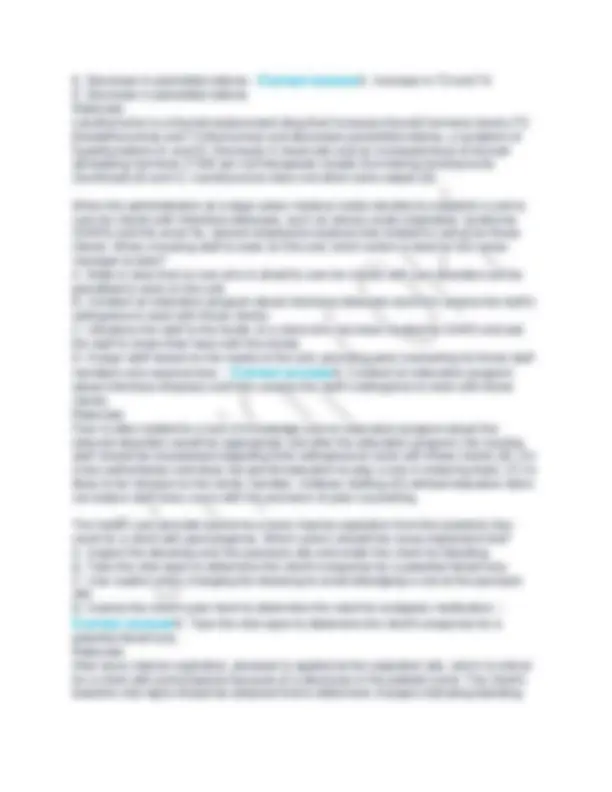
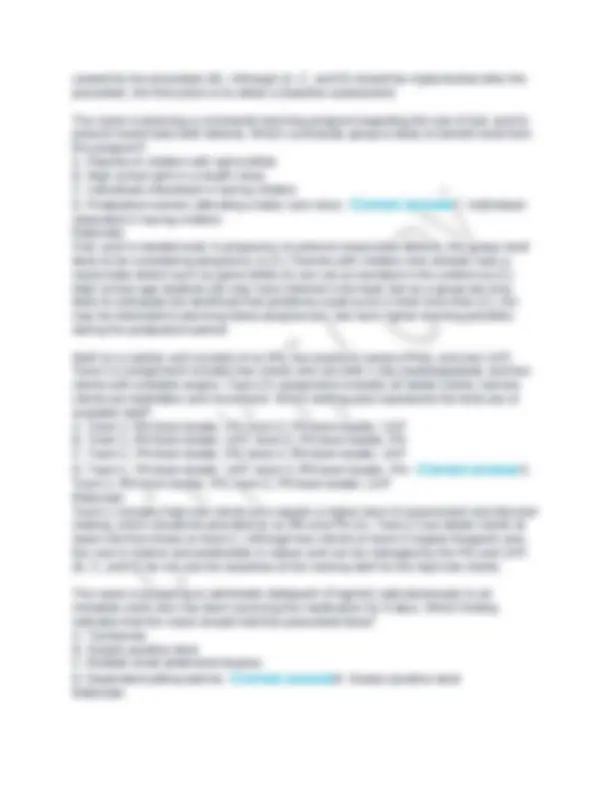
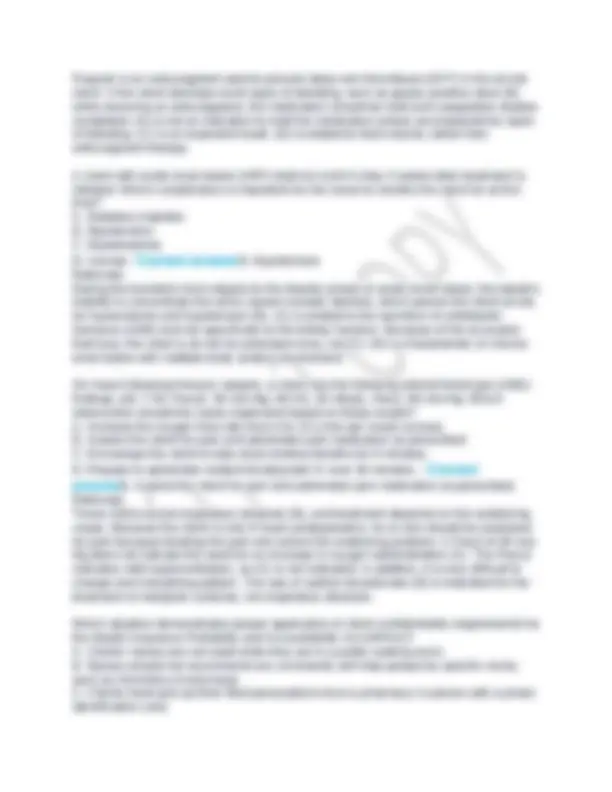
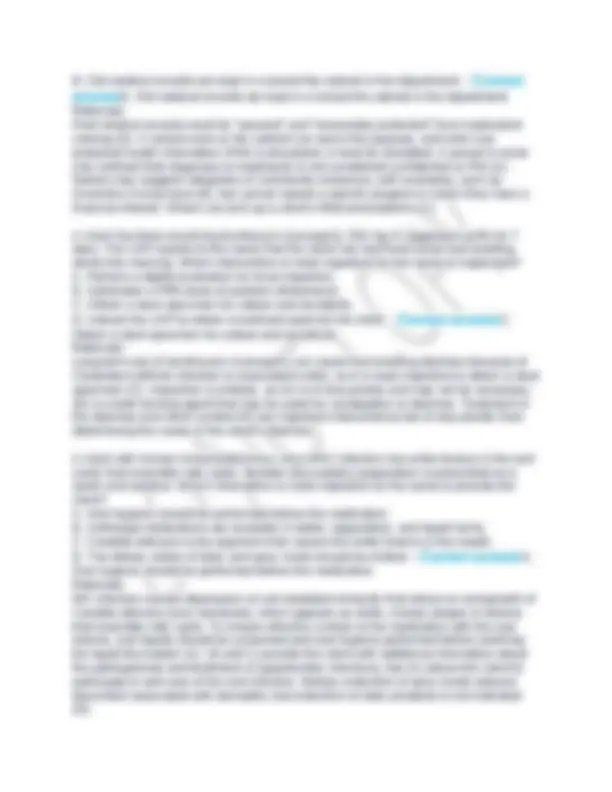
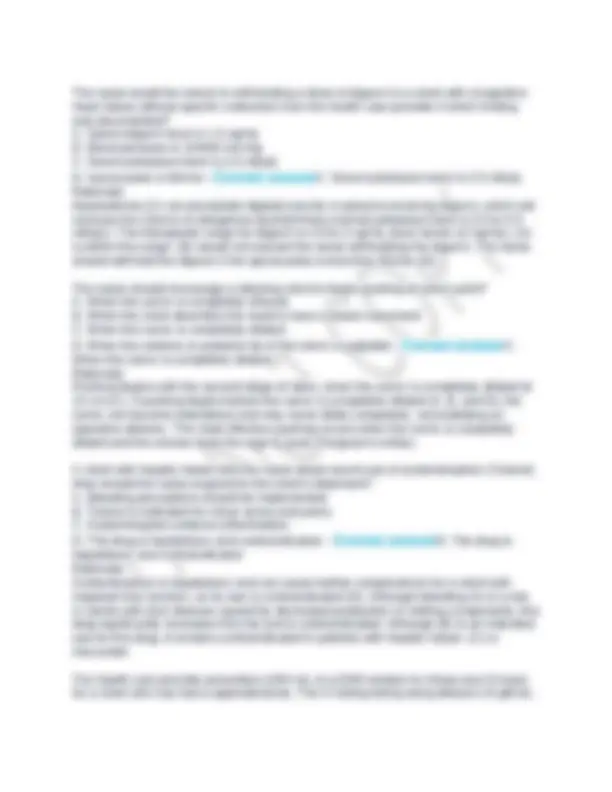
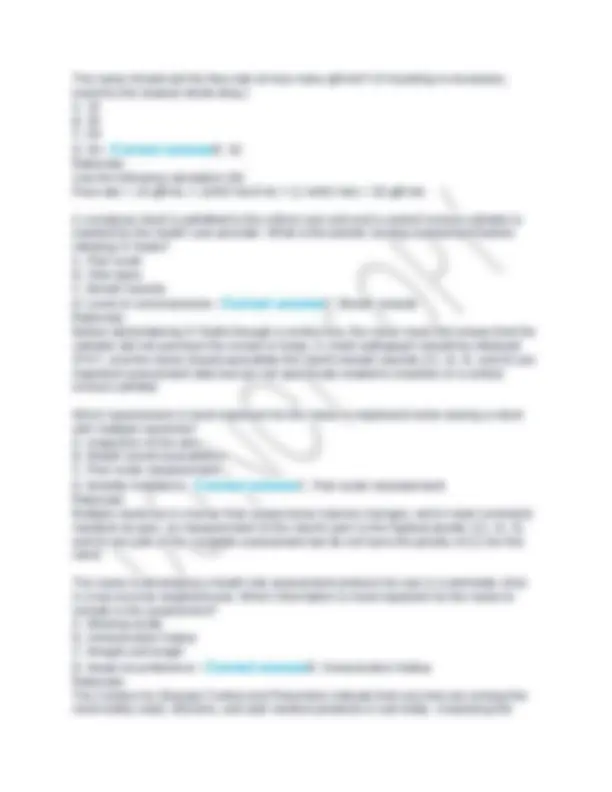
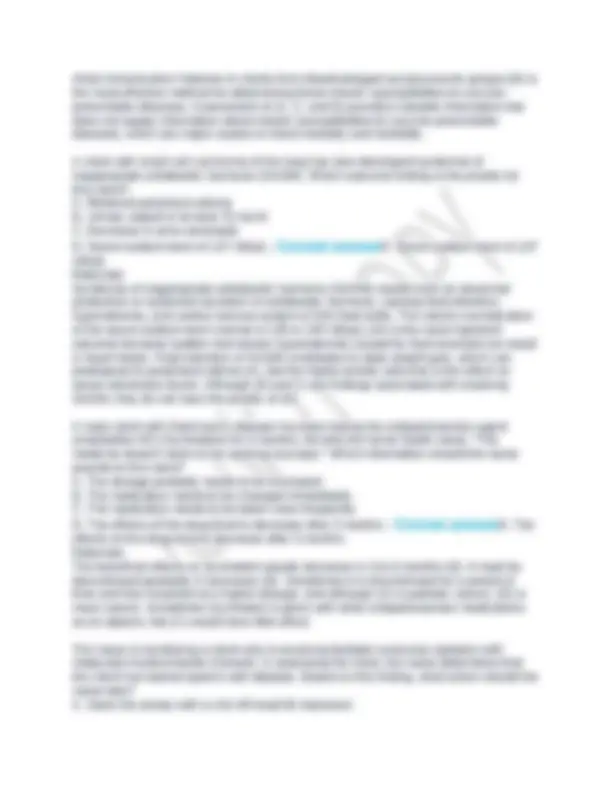
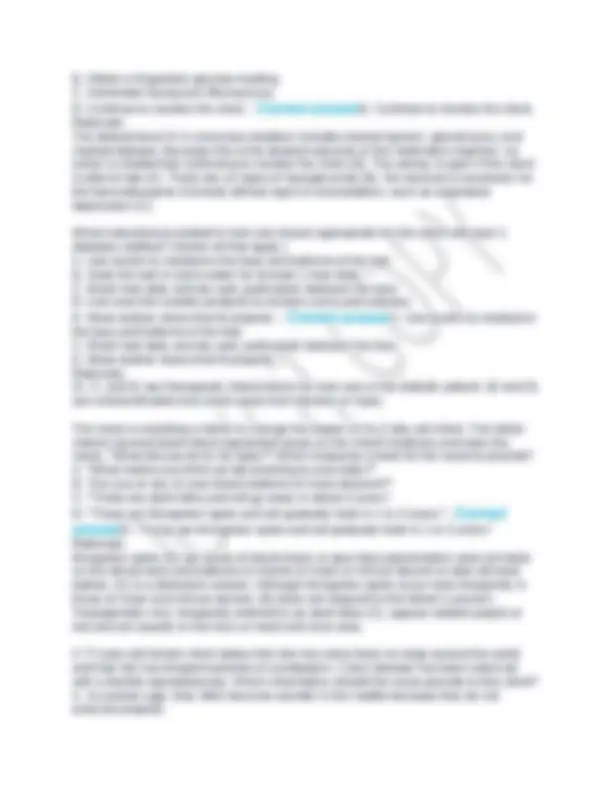
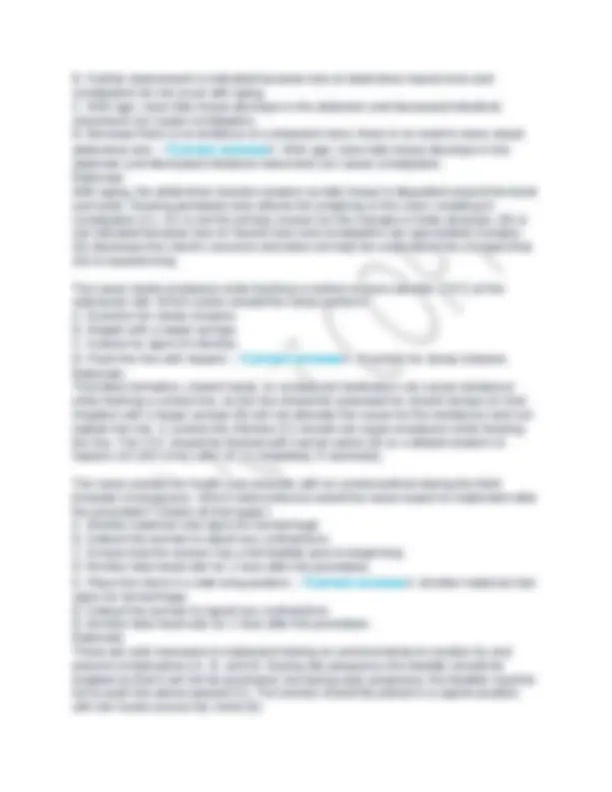
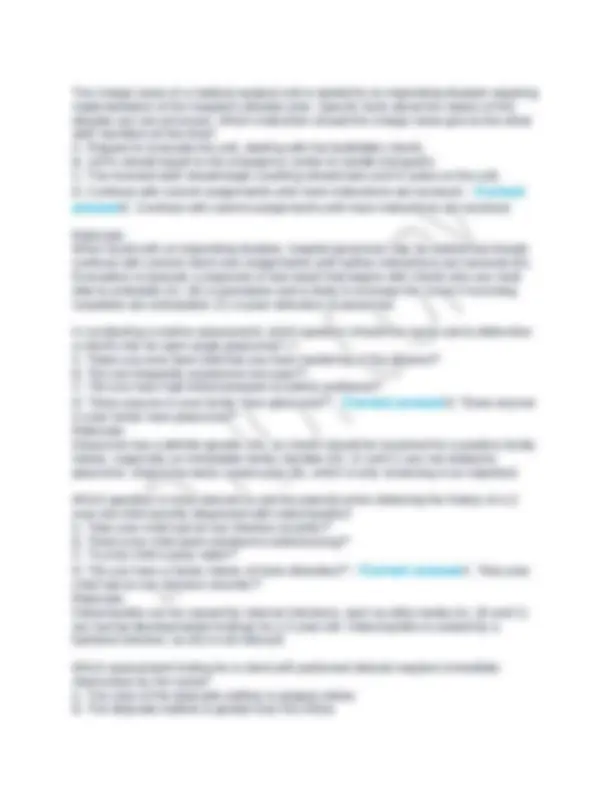
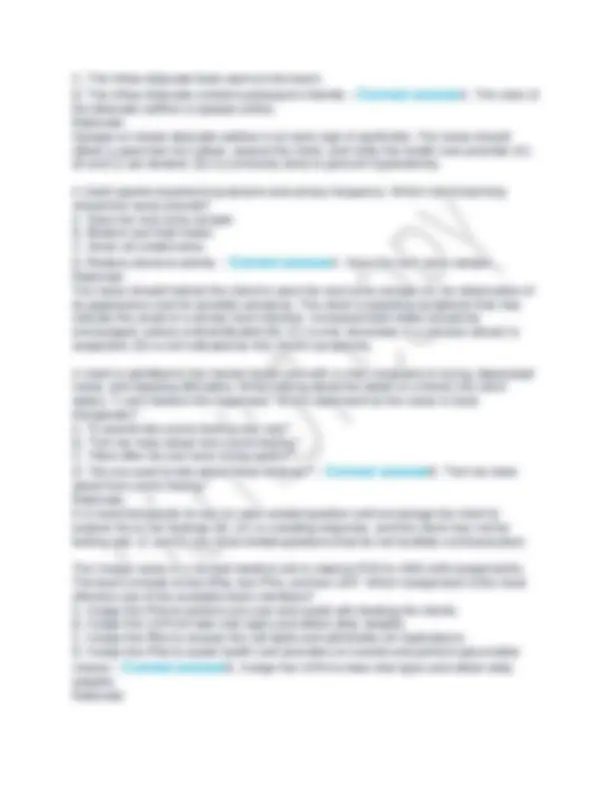
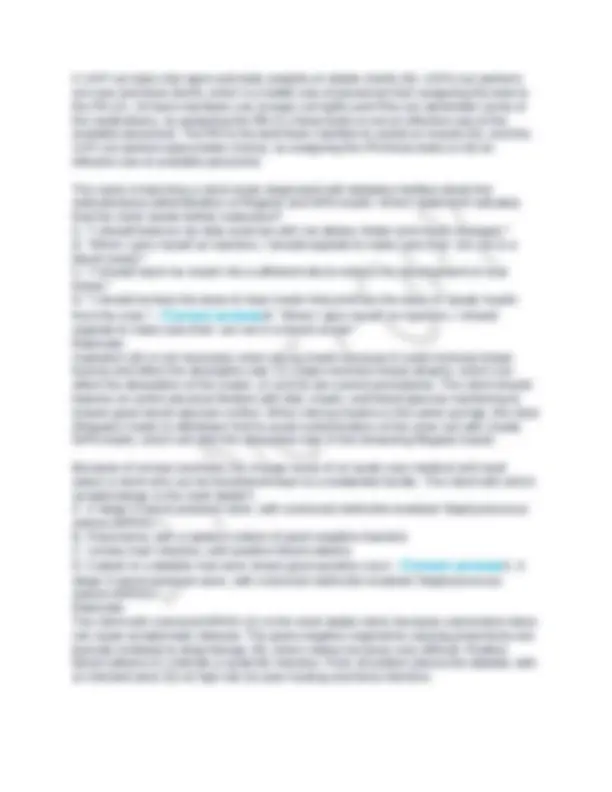
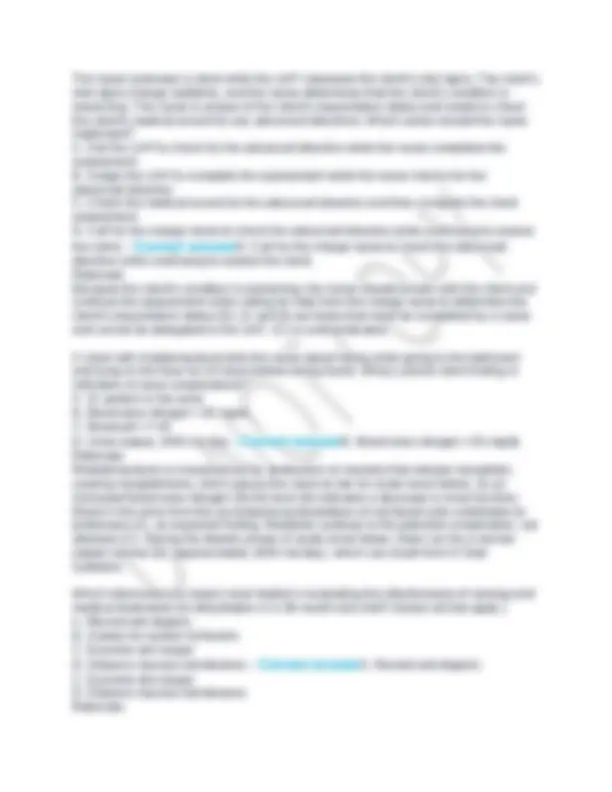
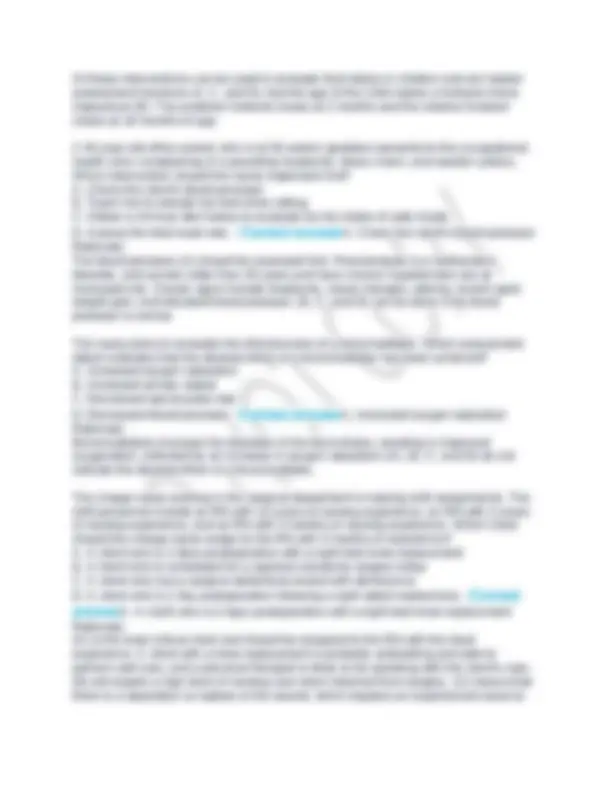
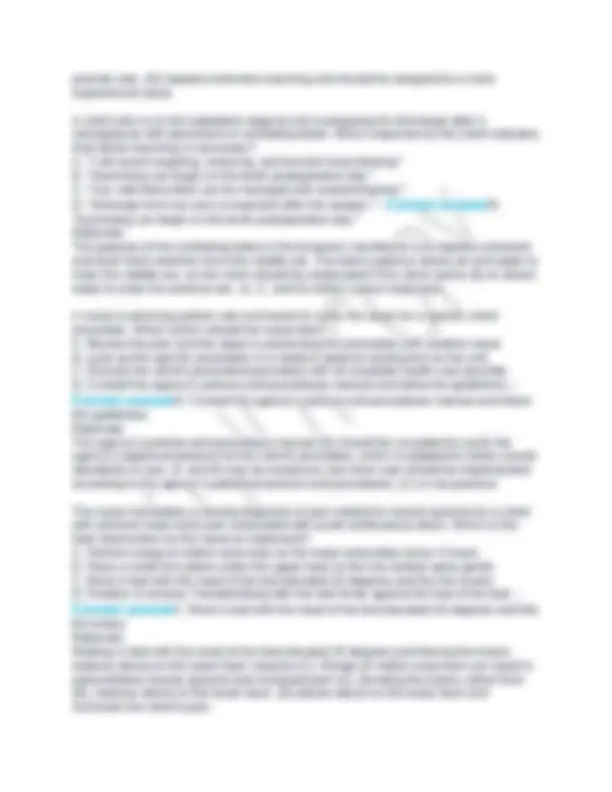
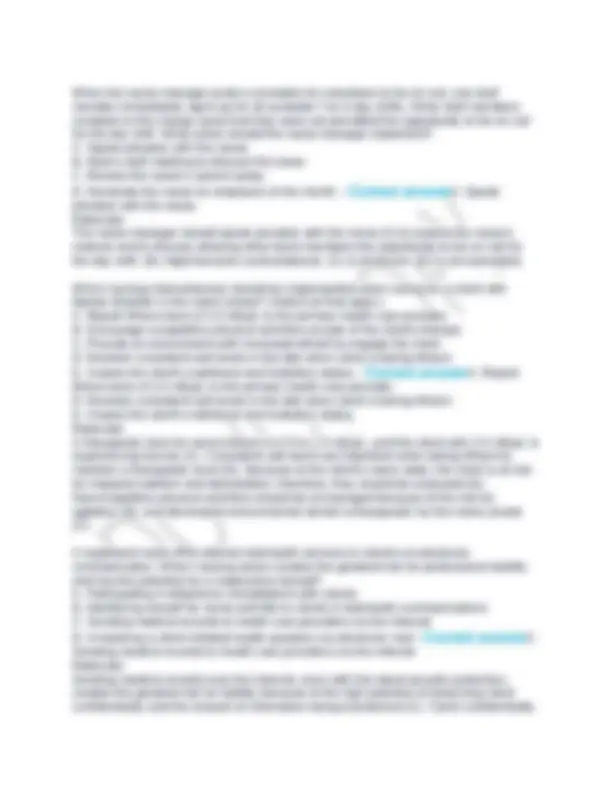
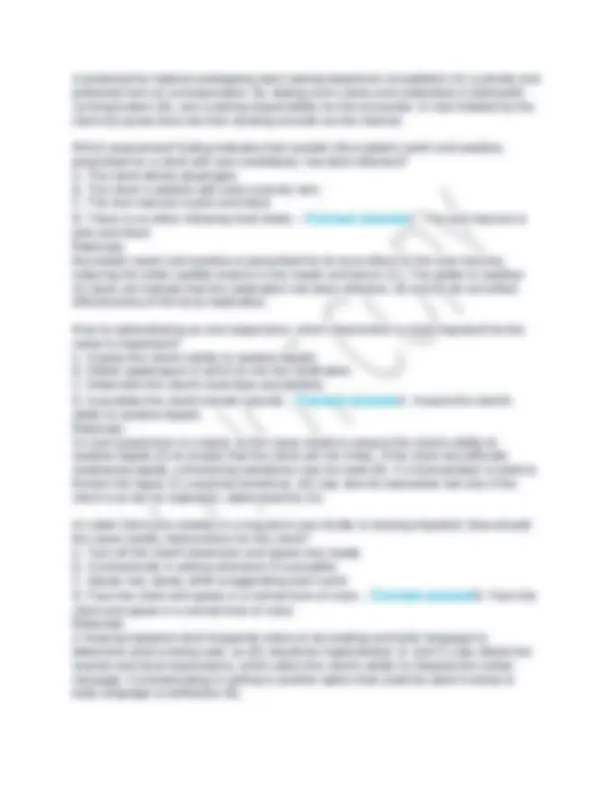
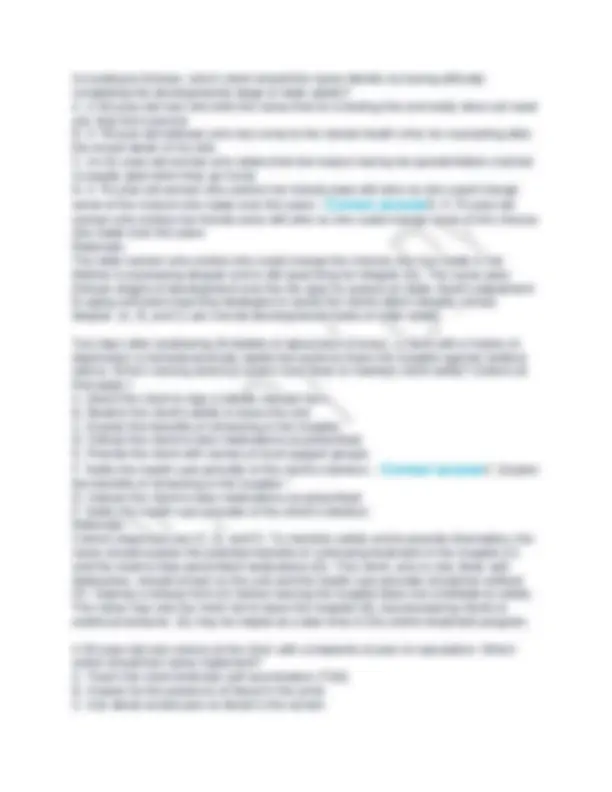
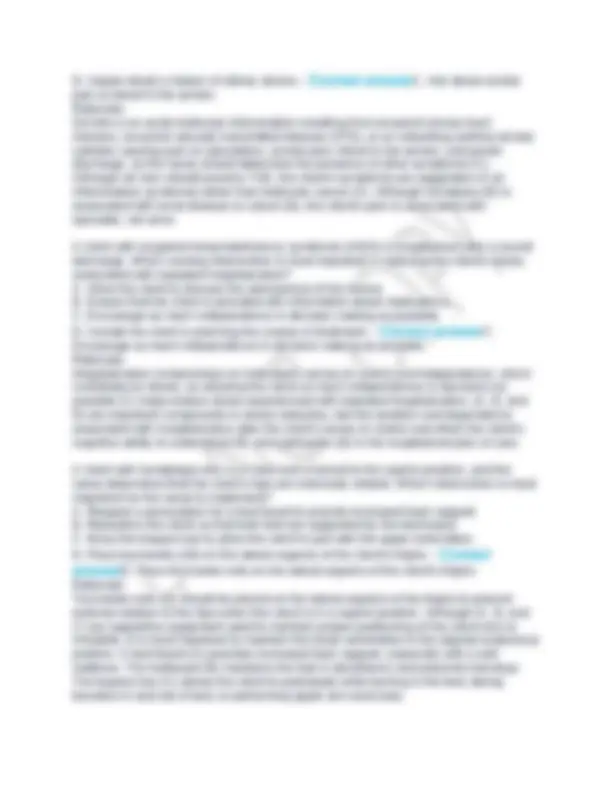
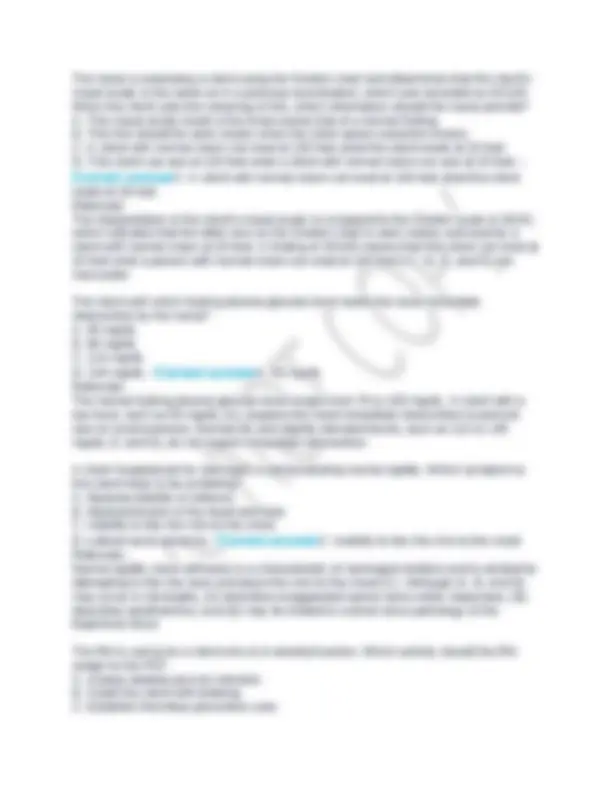
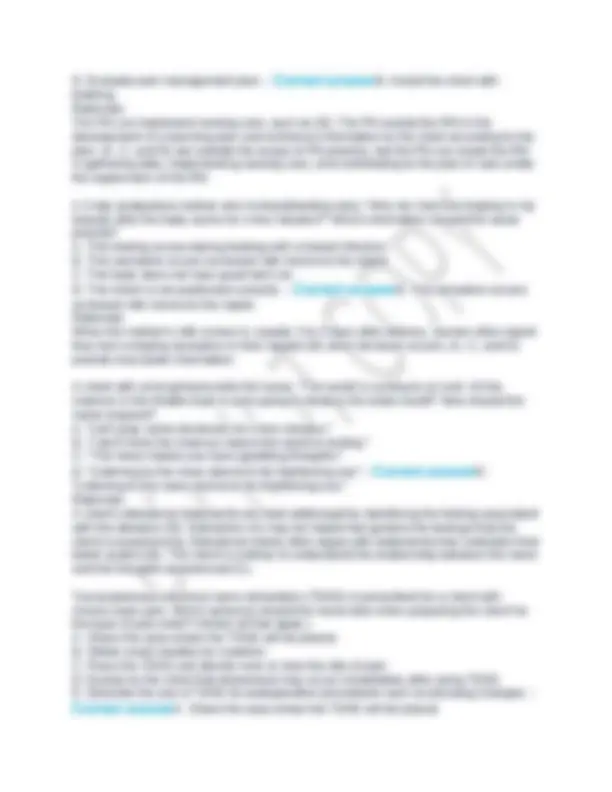
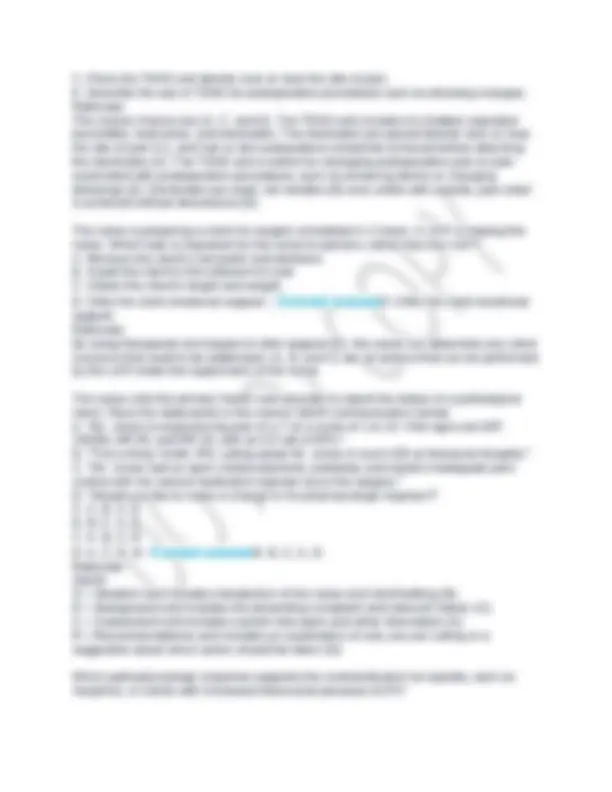
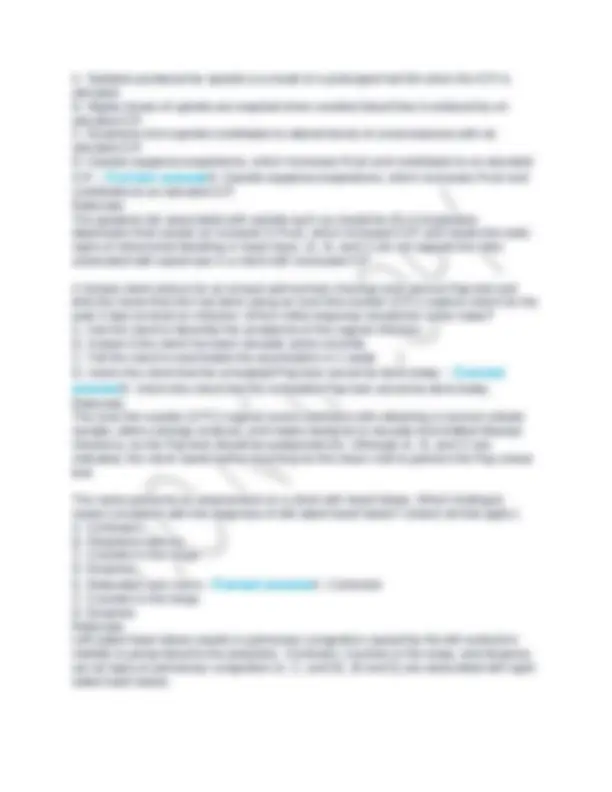
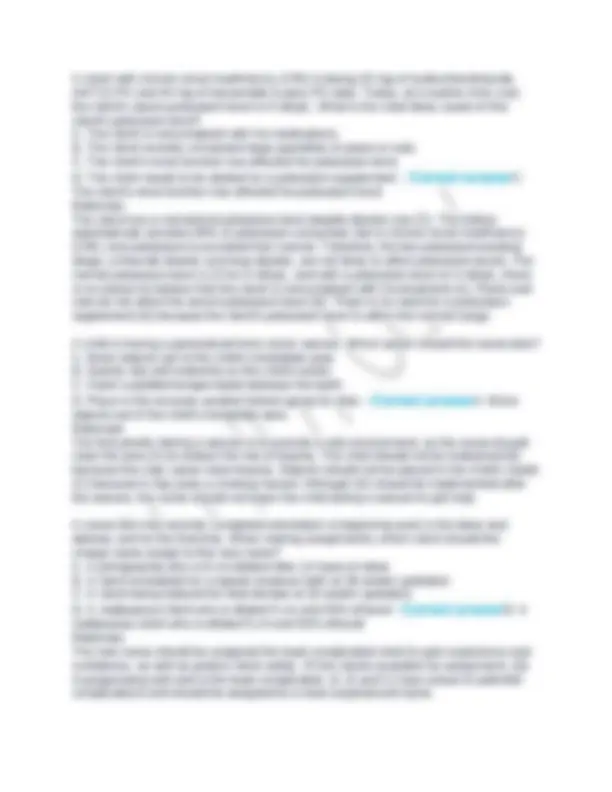
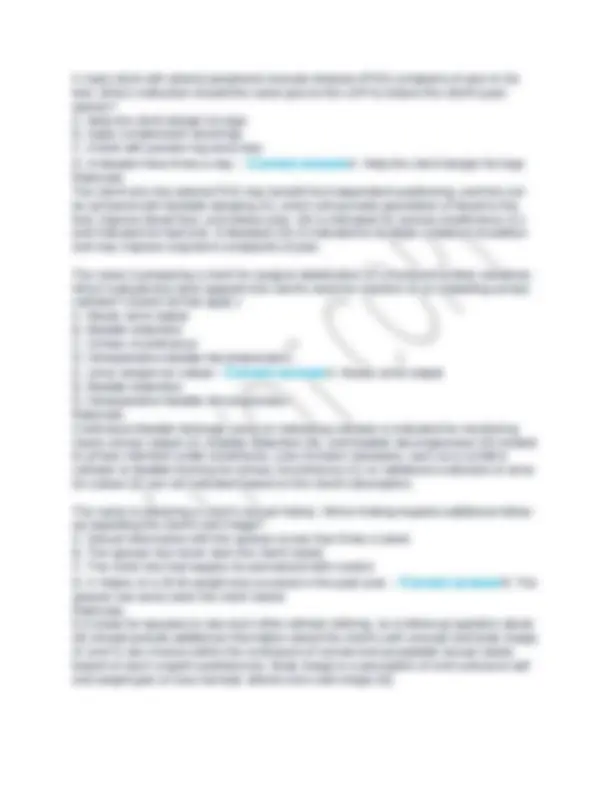
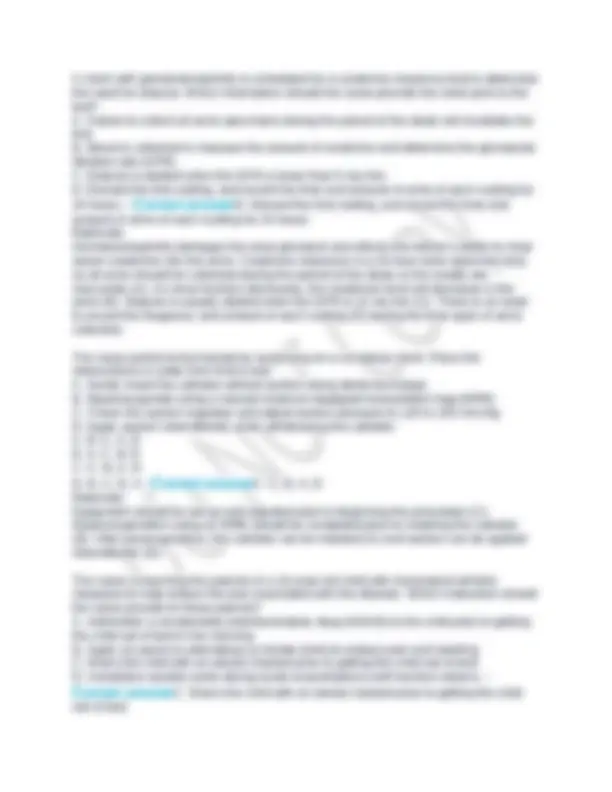
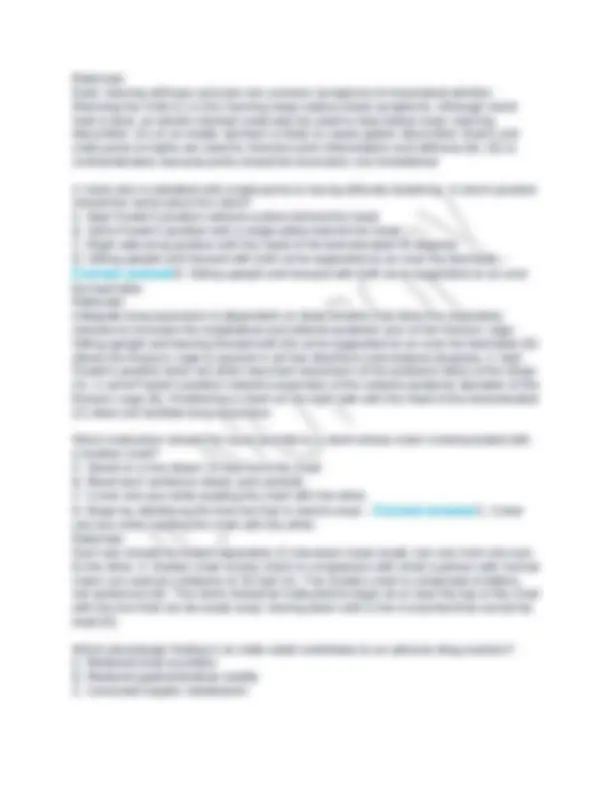
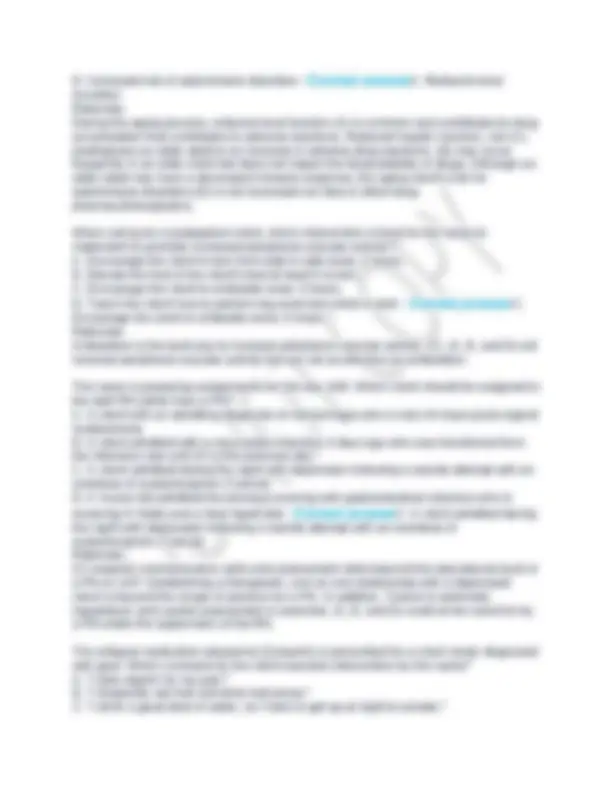
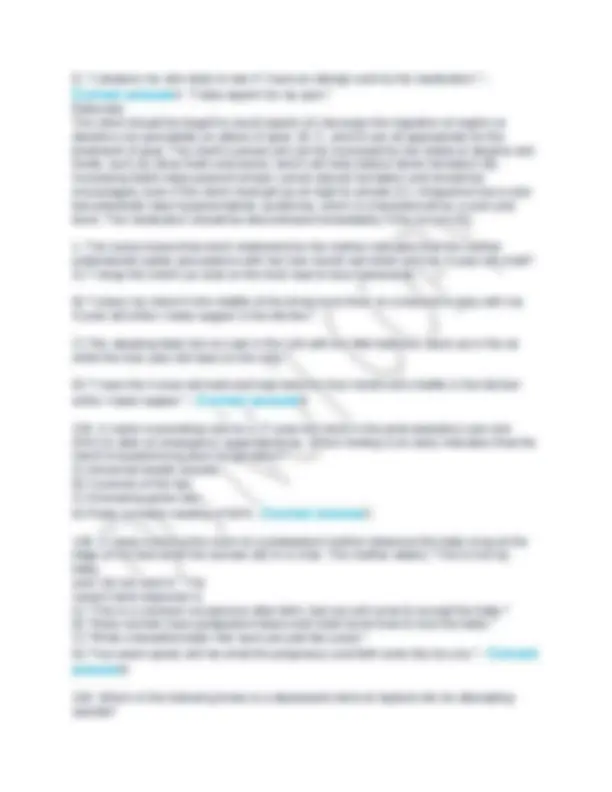
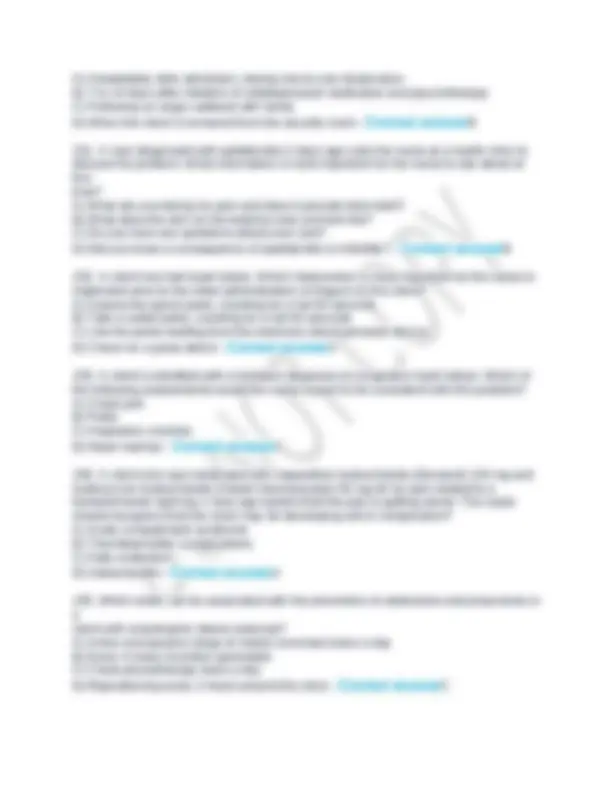
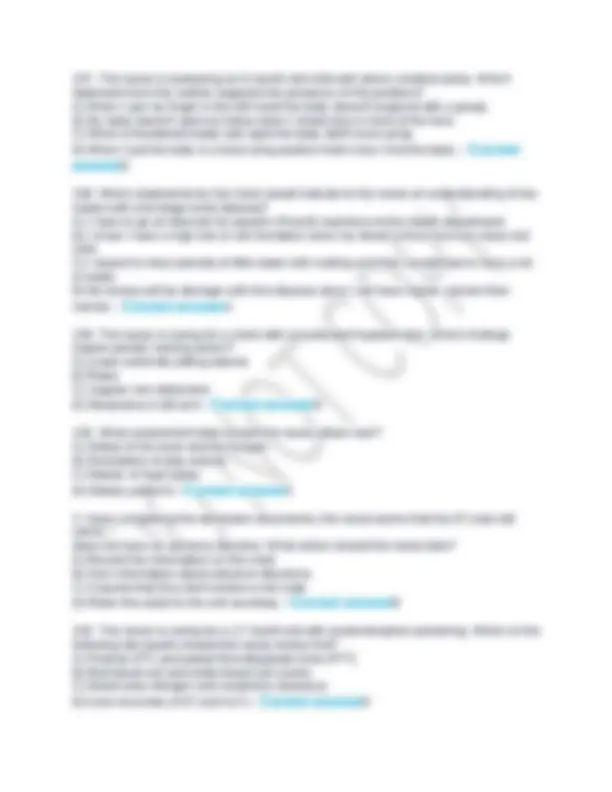
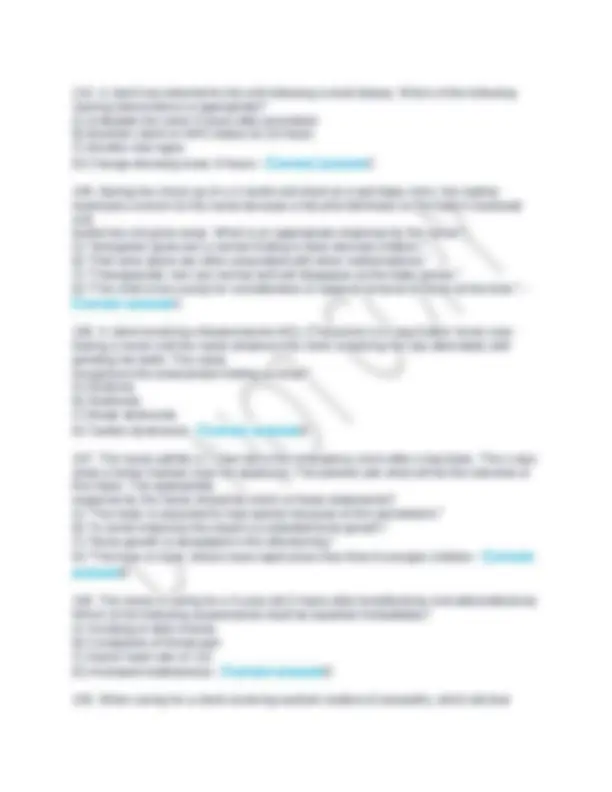
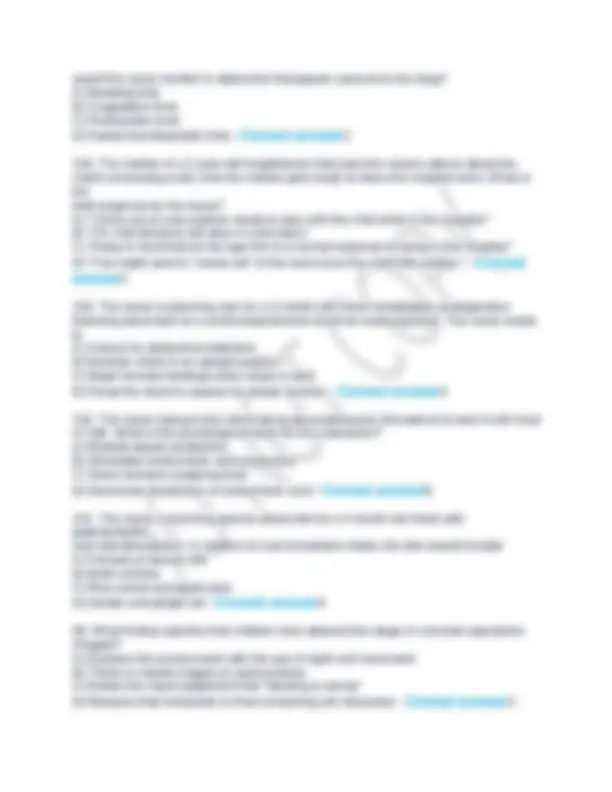
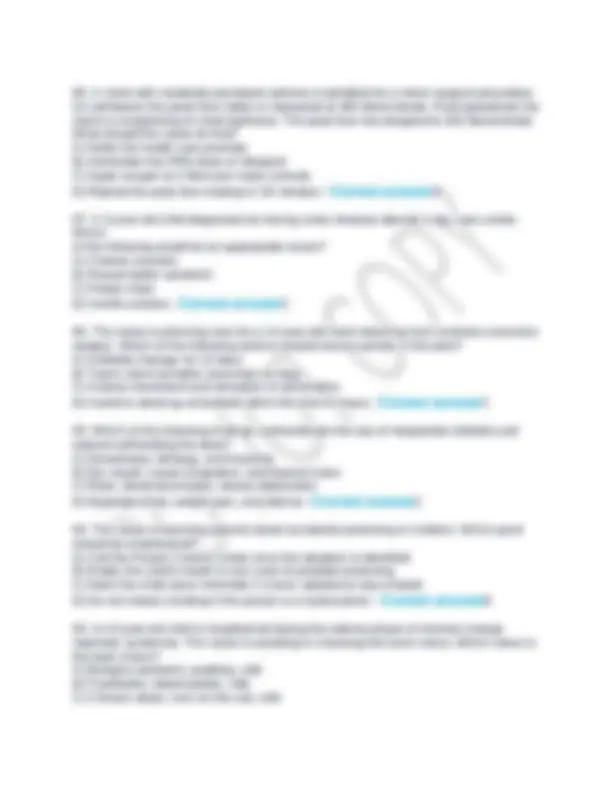

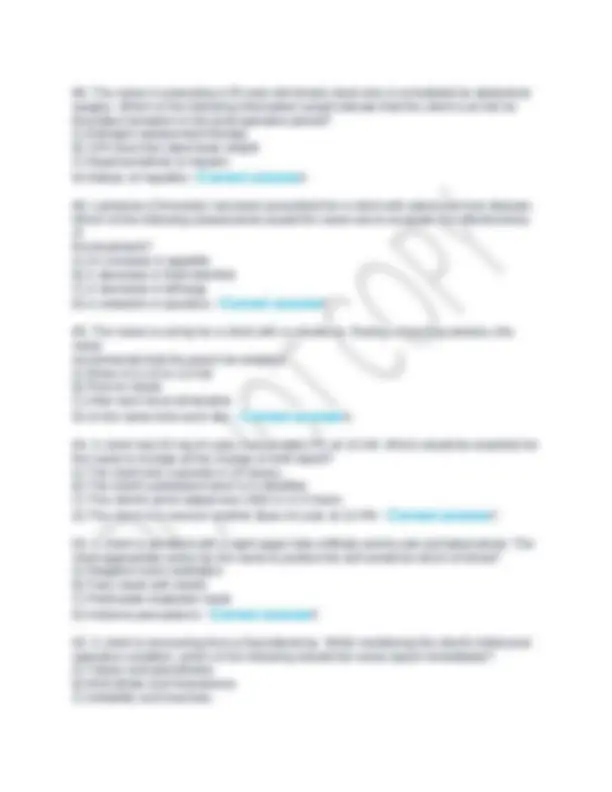
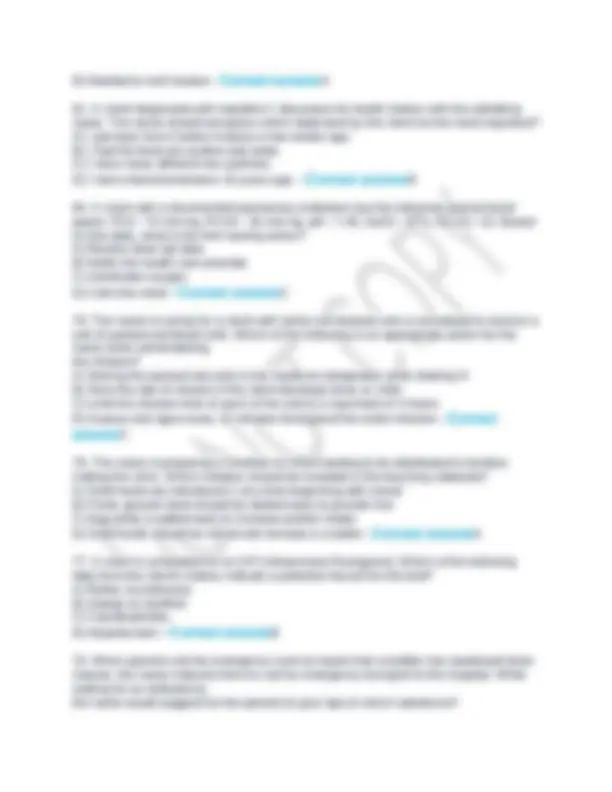
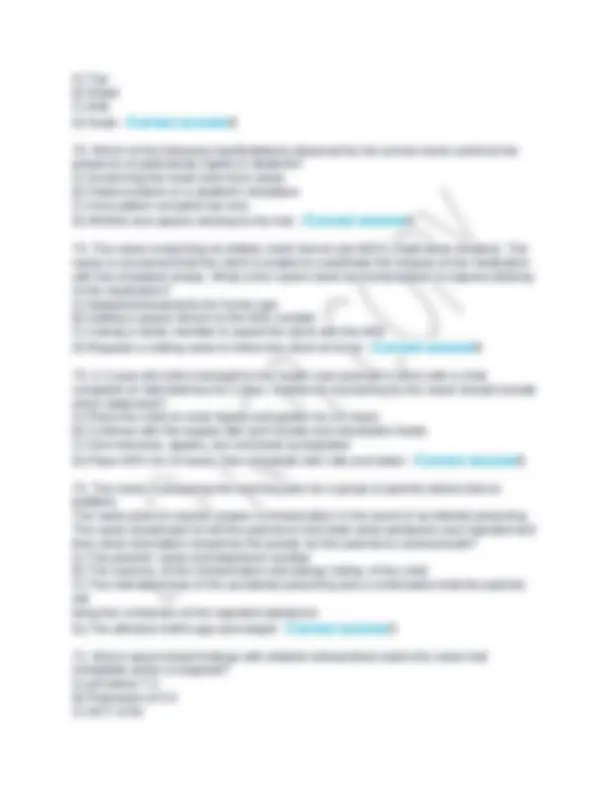
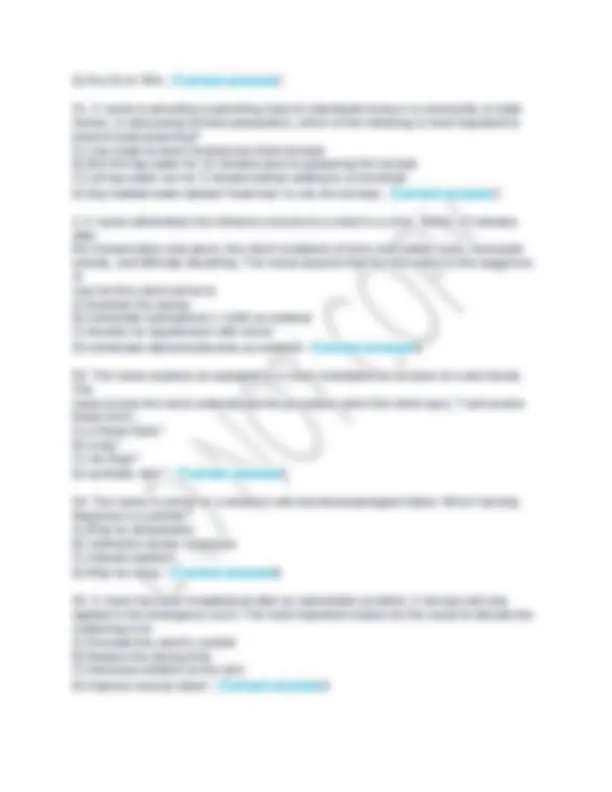
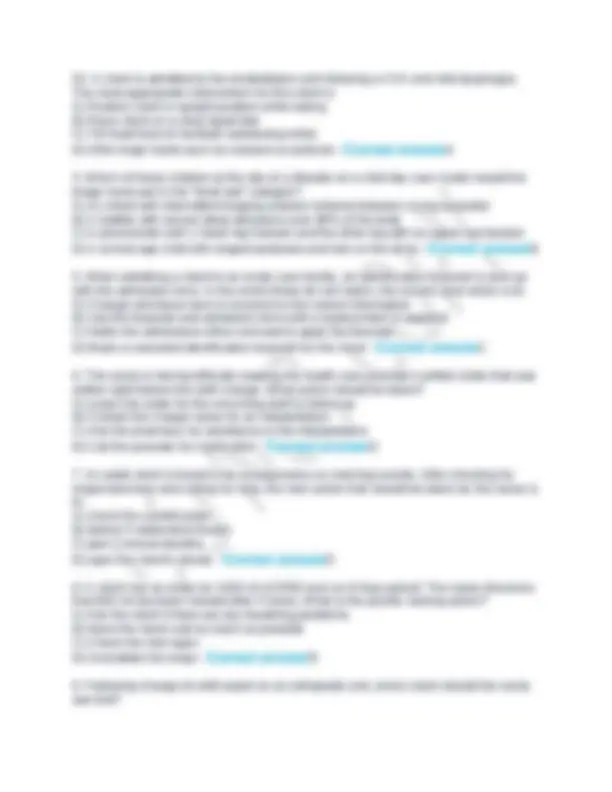
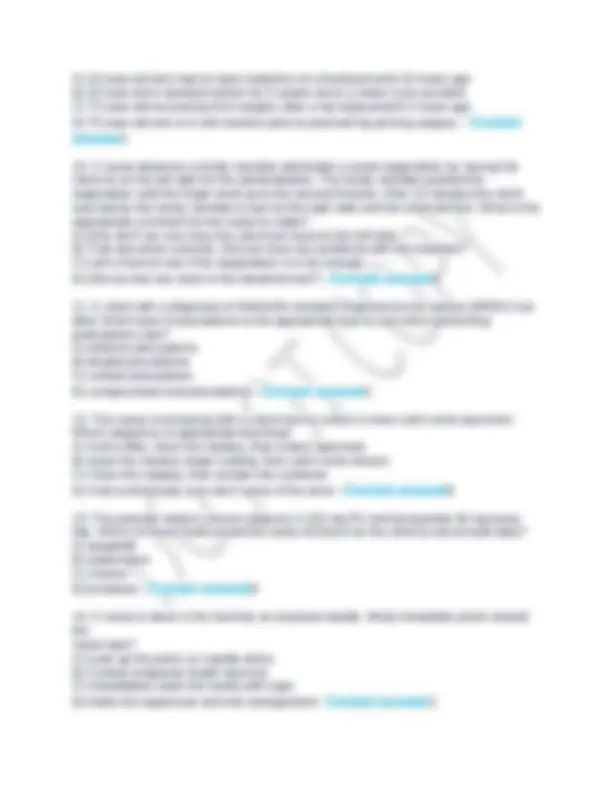
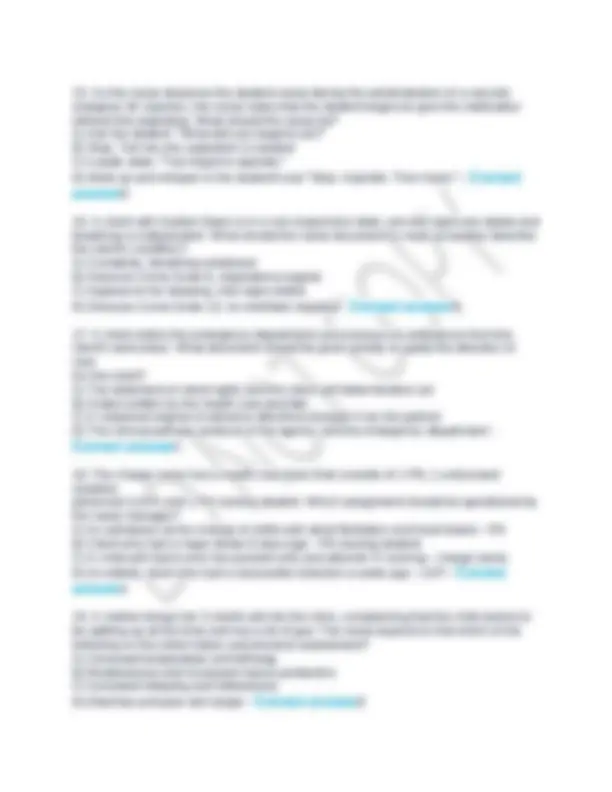
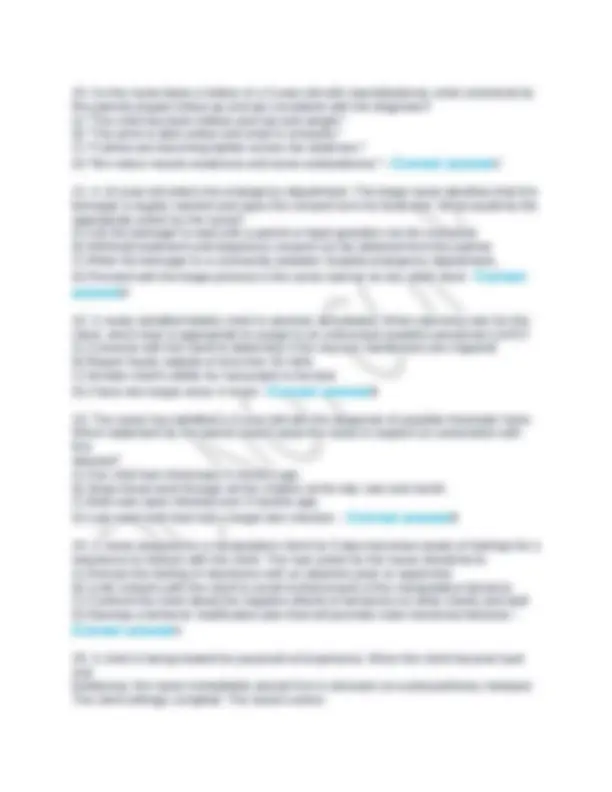
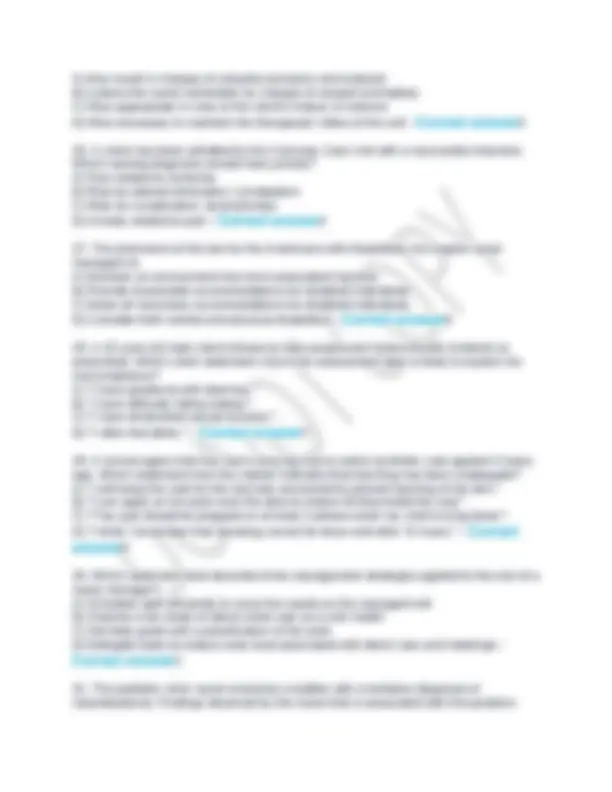
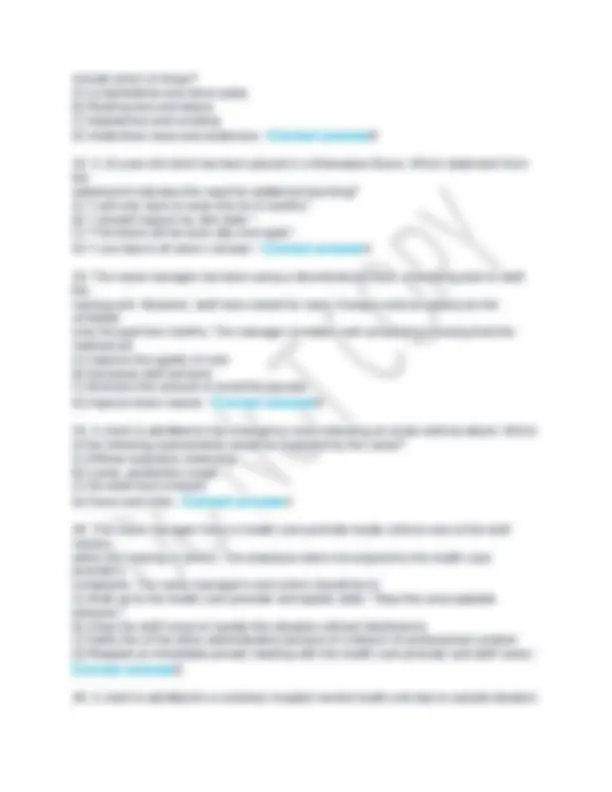
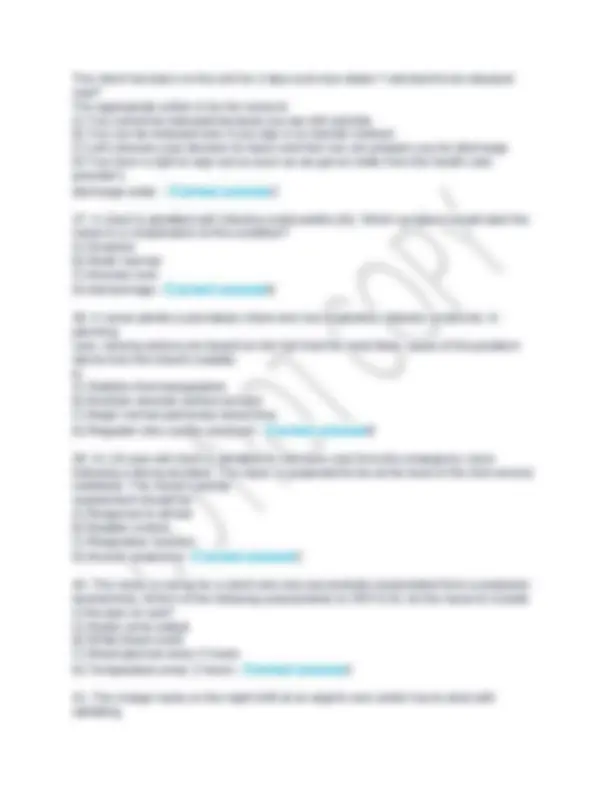
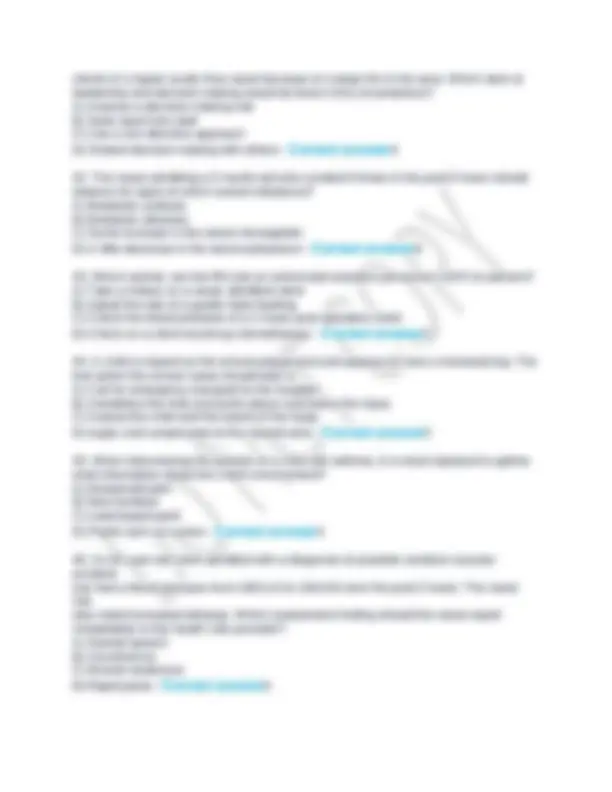
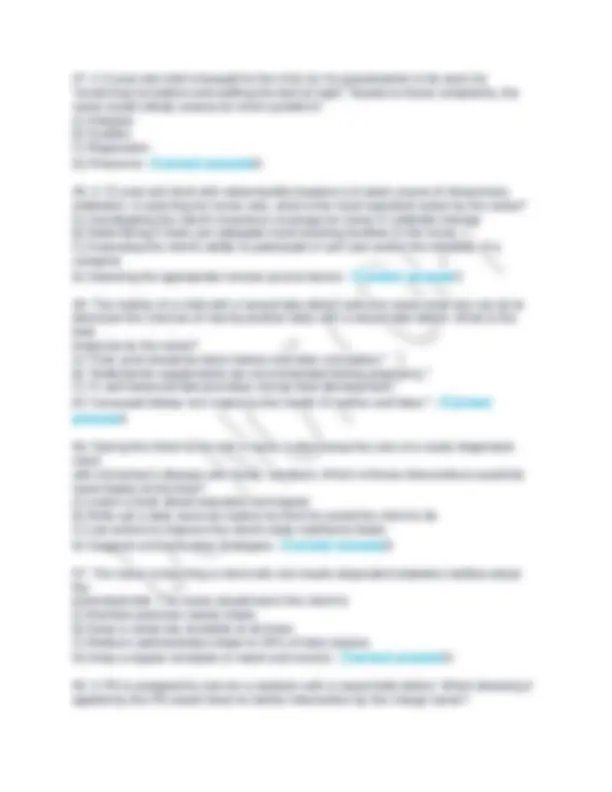
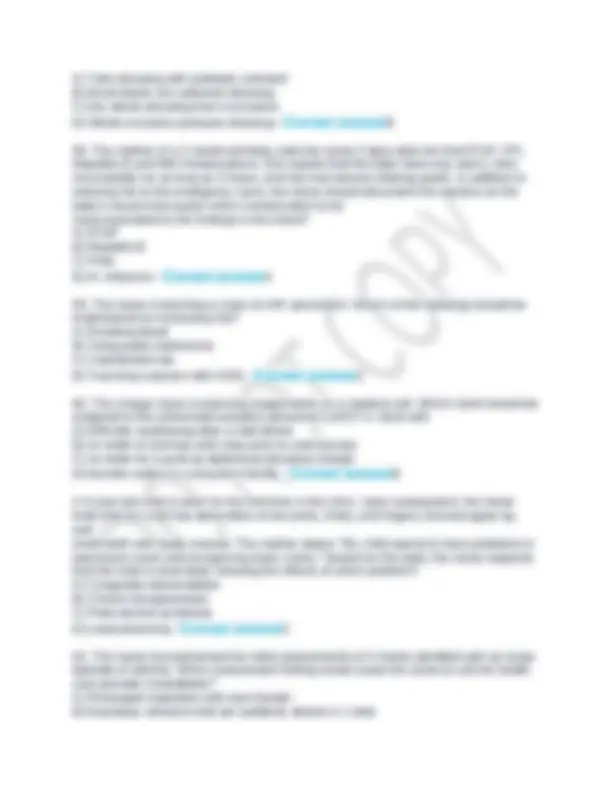
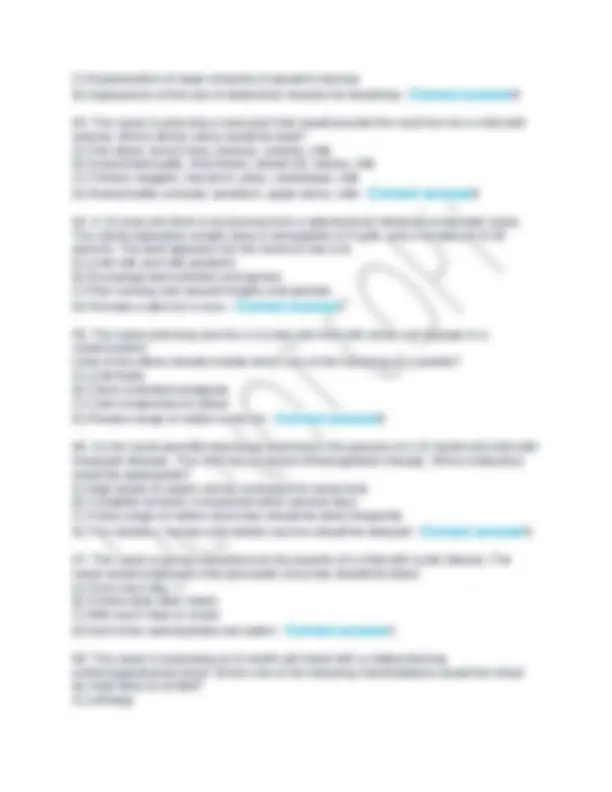
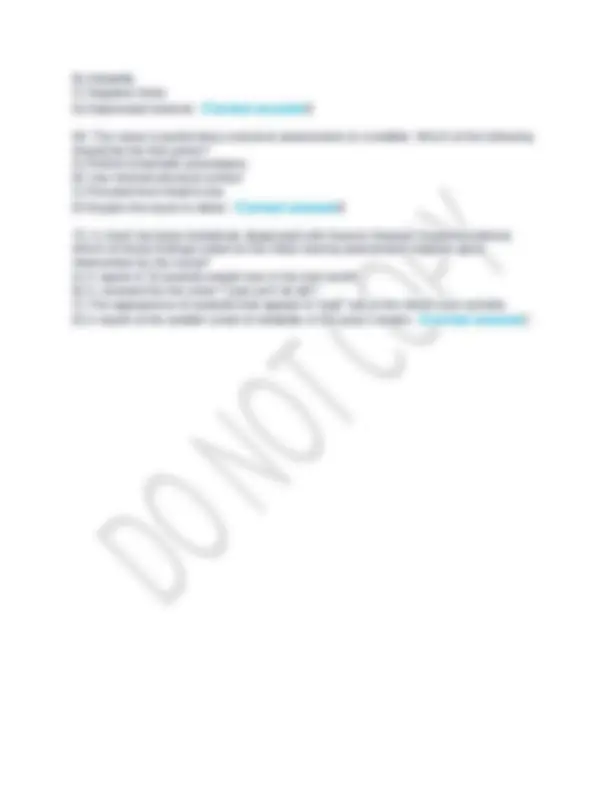


Study with the several resources on Docsity

Earn points by helping other students or get them with a premium plan


Prepare for your exams
Study with the several resources on Docsity

Earn points to download
Earn points by helping other students or get them with a premium plan
Community
Ask the community for help and clear up your study doubts
Discover the best universities in your country according to Docsity users
Free resources
Download our free guides on studying techniques, anxiety management strategies, and thesis advice from Docsity tutors
HESI Comprehensive B, Comprehensive Exam A, 2020 exit v 2 Updated 2025HESI Comprehensive B, Comprehensive Exam A, 2020 exit v 2 Updated 2025
Typology: Exams
1 / 86

This page cannot be seen from the preview
Don't miss anything!















































































The nurse is caring for a client with a cerebrovascular accident (CVA) who is receiving enteral tube feedings. Which task performed by the UAP requires immediate intervention by the nurse? A.Suctions oral secretions from mouth B.Positions head of bed flat when changing sheets C.Takes temperature using the axillary method
Rationale: Positioning the head of the bed flat when enteral feedings are in progress puts the client at risk for aspiration (B). The others are all acceptable tasks performed by the UAP (A, C, and D). When caring for a postsurgical client who has undergone multiple blood transfusions, which serum laboratory finding is of most concern to the nurse? A.Sodium level, 137 mEq/L B.Potassium level, 5.5 mEq/L C.Blood urea nitrogen (BUN) level, 18 mg/dL
Rationale: Multiple blood transfusions are a risk factor for hyperkalemia. A serum potassium level higher than 5.0 mEq/L indicates hyperkalemia (B). The others are normal findings (A, C, and D). Which vaccination should the nurse administer to a newborn? A.Hepatitis B B.Human papilloma virus (HPV) C.Varicella
Rationale: The hepatitis B vaccination should be given to all newborns before hospital discharge (A). HPV is not recommended until adolescence (B). Varicella immunization begins at 12 months (C). Meningococcal vaccine is administered beginning at 2 years (D). The nurse is caring for a client on the medical unit. Which task can be delegated to unlicensed assistive personnel (UAP)? A.Assess the need to change a central line dressing. B.Obtain a fingerstick blood glucose level. C.Answer a family member's questions about the client's plan of care.
D.Teach the client side effects to report related to the current medication regimen. -
Rationale: Obtaining a fingerstick blood glucose level is a simple treatment and is an appropriate skill for UAP to perform (B). (A, C, and D) are skills that cannot be delegated to UAP. The nurse is caring for a client with an ischemic stroke who has a prescription for tissue plasminogen activator (t-PA) IV. Which action(s) should the nurse expect to implement? (Select all that apply.) A.Administer aspirin with tissue plasminogen activator (t-PA). B.Complete the National Institute of Health Stroke Scale (NIHSS). C.Assess the client for signs of bleeding during and after the infusion. D.Start t-PA within 6 hours after the onset of stroke symptoms.
Rationale: Neurologic assessment, including the NIHSS, is indicated for the client receiving t-PA. This includes close monitoring for bleeding during and after the infusion; if bleeding or other signs of neurologic impairment occur, the infusion should be stopped (B, C, and E). Aspirin is contraindicated with t-PA because it increases the risk for bleeding (A). The administration of t-PA within 6 hours of symptoms is concurrent with a diagnosis of a myocardial infarction and within 4.5 hours of symptoms is concurrent for a stroke (D). When caring for a client in labor, which finding is most important to report to the primary health care provider? A.Maternal heart rate, 90 beats/min. B.Fetal heart rate, 100 beats/min C.Maternal blood pressure, 140/86 mm Hg
Rationale: A fetal heart rate (FHR) of 100 beats/min may indicate fetal distress (B) because the average FHR at term is 140 beats/min and the normal range is 110 to beats/min 160. The others (A, C, and D) are normal findings for a woman in labor. The nurse is caring for a client with heart failure who develops respiratory distress and coughs up pink frothy sputum. Which action should the nurse take first? A.Draw arterial blood gases. B.Notify the primary health care provider. C.Position in a high Fowler's position with the legs down.
Rationale: Positioning the patient in a high Fowler's position with dangling feet will decrease further venous return to the left ventricle (C). The other actions should be performed after the change in position (A, B, and D).
increase the risk for hemorrhage (A). The infusion should be stopped, and vitamin K is the antidote for warfarin (Coumadin) (B). Keeping the infusion at the current rate would increase the risk for hemorrhage (C). While assessing a client with recurring chest pain, the unit secretary notifies the nurse that the client's health care provider is on the telephone. What action should the nurse instruct the unit secretary to implement? A.Transfer the call into the room of the client. B.Instruct the secretary to explain reason for the call. C.Ask another nurse to take the phone call.
Rationale: Another nurse should be asked to take the phone call (C), which allows the nurse to stay at the bedside to complete the assessment of the client's chest pain. (A and B) should not be done during an acute change in the client's condition. Requesting the health care provider (D) to come to the unit is premature until the nurse completes assessment of the client's status. Which instruction(s) should the nurse include in the discharge teaching plan of a male client who has had a myocardial infarction and who has a new prescription for nitroglycerin (NTG)? (Select all that apply.) A.Keep the medication in your pocket so that it can be accessed quickly. B.Call 911 if chest pain is not relieved after one nitroglycerin. C.Store the medication in its original container and protect it from light. D.Activate the emergency medical system after three doses of medication.
Rationale: Emergency action should be taken if chest pain is not relieved after one nitroglycerin tablet (B). The medication should be kept in the original container to protect from light (C). Keeping the medication in the shirt pocket provides an environment that is too warm (A). The newest guidelines recommend calling 911 after one nitroglycerin tablet if chest pain is not relieved (D). Nitroglycerin and other nitrates should never be taken with Viagra (E). The nurse prepares to administer 3 units of regular insulin and 20 units of NPH insulin subcutaneously to a client with an elevated blood glucose level. Which procedure is correct? A.Using one syringe, first insert air into the regular vial and then insert air into the NPH vial. B.Using one syringe, add the regular insulin into the syringe and then add the NPH insulin. C.Avoid combining the two insulins because incompatibility could cause an adverse reaction. D.Administer the regular insulin subcutaneously and then give the NPH IV to prevent a
Rationale:
The regular or "clear" insulin should be withdrawn into the syringe first, followed by the NPH (B). Air should first be injected into the NPH vial and then air should be inserted into the regular vial (A). NPH and regular insulin are compatible, and combining will reduce the number of injections (C). The insulin is ordered subcutaneously and NPH cannot be given IV (D). An 8-year-old child is receiving digoxin (Lanoxin) for congestive heart failure (CHF). In assessing the child, the nurse finds that her apical heart rate is 80 beats/min, she complains of being slightly nauseated, and her serum digoxin level is 1.2 ng/mL. What action should the nurse take? A.Because the child's heart rate and digoxin level are within normal range, assess for the cause of the nausea. B.Hold the next dose of digoxin until the health care provider can be notified because the serum digoxin level is elevated. C.Administer the next dose of digoxin and notify the health care provider that the child is showing signs of toxicity. D.Notify the health care provider that the child's pulse rate is below normal for her age
Rationale: Nausea and vomiting are early signs of digoxin toxicity. However, the normal resting heart rate for a child 8 to 10 years of age is 70 to 110 beats/min and the therapeutic range of serum digoxin levels is 0.5 to 2 ng/mL. Based on the objective data, (A) is the best of the choices provided because the serum digoxin level is within normal levels. (B) is not warranted by the data presented. The digoxin level is within the therapeutic range and the child is not showing signs of toxicity (C). The child's pulse rate is within normal range for her age group (D). The nurse prepares to administer acetaminophen oral suspension to a child who weighs 66 pounds. The prescription reads: Administer 15 mg/kg every 6 hours by mouth. The Tylenol is available 150 mg/5 ml. Which is the correct dosage indicated on the image? A.30ml B.15ml C.10ml
Rationale: 66 lb/(2.2 kg/lb) = 30 kg 30 kg × (15 mg/kg) = 450 mg (5 mL/150 mg) × 450 mg = 15 mL or (450 mg/150 mg) × 5 mL = 15 mL When assessing the laboratory findings of a 38-year-old client with tuberculosis who is taking rifampin (Rifadin), which laboratory finding would be most important to report to the primary health care provider immediately? A.Orange-colored urine B.Potassium level, 4.9 mEq/L
Which vital sign in a pediatric client is most important to report to the primary health care provider? A.Newborn with a heart rate of 140 beats/min B.Three-year-old with a respiratory rate of 28 breaths/min C.Six-year-old with a heart rate of 130 beats/min
Rationale: The normal heart rate for a 6- to 10-year-old is 70 to 110 beats/min (C). The others are all within normal range for those ages (A, B, and D). Which finding should be reported to the primary health care provider when caring for a client who has a continuous bladder irrigation after a transurethral resection of the prostate gland (TURP)? A.The client reports a continuous feeling of needing to void. B.Urinary drainage is pink 24 hours after surgery. C.The hemoglobin level is 8.4 g/dL 3 days postoperatively.
Rationale: A hemoglobin level of 8.4 g/dL is abnormally low and may indicate hemorrhage (C). The others are all expected findings after a TURP (A, B, and D). Which of the following cardiac rhythms is represented in the image? A.Normal sinus rhythm B.Sinus tachycardia C.Ventricular fibrillation
Rationale: Ventricular fibrillation (C) is a life-threatening arrhythmia characterized by irregular undulations of varying amplitudes. (A, B, and D) are not represented in the image. An adult client with a medical diagnosis of substance abuse and schizophrenia was recently switched from oral fluphenazine HCl (Prolixin) to IM fluphenazine decanoate (Prolixin Decanoate) because of medication noncompliance. What should the nurse teach the client and family about this change in medication regimen? A.Long-acting medication is more effective than daily medication. B.A client with substance abuse must not take any oral medications. C.There will continue to be a risk of alcohol and drug interaction.
Rationale: Alcohol enhances the side effects of Prolixin. The half-life of Prolixin PO is 8 hours, whereas the half-life of the Prolixin Decanoate IM is 2 to 4 weeks. Therefore, the side effects of drinking alcohol are far more severe when the client drinks alcohol after taking the long-acting Prolixin Decanoate IM (C). (A, B, and D) provide incorrect information.
A client comes to the obstetric clinic for her first prenatal visit and complains of feeling nauseated every morning. The client tells the nurse, "I'm having second thoughts about wanting to have this baby." Which response is best for the nurse to make? A."It's normal to feel ambivalent about a pregnancy when you are not feeling well." B."I think you should discuss these feelings with your health care provider." C."How does the father of your child feel about your having this baby?" D."Tell me about these second thoughts you are having about this pregnancy." -
Rationale: Although ambivalence is normal during the first trimester, (D) is the best nursing response at this time. It is reflective and keeps the lines of communication open. (A) is not the best response because it offers false reassurance. (B) dismisses the client's feelings. The nurse should use communication skills that encourage this type of discussion, not shift responsibility to the care provider. (C) may eventually be discussed, but it is not the most important information to obtain at this time. A nurse performs an initial admission assessment of a 56-year-old client. Which factor(s) would indicate that the client is at risk for metabolic syndrome? (Select all that apply.) A.Abdominal obesity B.Sedentary lifestyle C.History of hypoglycemia D.Hispanic or Asian ethnicity
Rationale: Metabolic syndrome is a name for a group of risk factors that increase the risk for coronary artery disease, type 2 diabetes, and stroke (A, B, D, and E). Hypoglycemia is not a risk factor for metabolic syndrome (C). The nurse administers regular insulin (human), 8 units subcutaneously, to a client at 8:00 am, 30 minutes before breakfast. At what time is the client most at risk for a hypoglycemic reaction? A.9:30 am B.10:30 am C.12:00 pm
Rationale: Regular insulin is short-acting and peaks between 2 and 3 hours after administration (B). The client is most at risk for a hypoglycemic reaction during the peak times. (A, C, and D) are not high-risk times for the client to experience hypoglycemia because they do not fall within the peak time. Which intervention is most important when caring for a client immediately after electroconvulsive therapy (ECT)?A.Reorient the client to surroundings. B.Assess blood pressure every 15 minutes. C.Determine if muscle soreness is present.
The nurse is caring for a client with chronic renal failure (CRF) who is receiving dialysis therapy. Which nursing intervention has the greatest priority when planning this client's care? A.Palpate for pitting edema. B.Provide meticulous skin care. C.Administer phosphate binders.
Rationale: Clients with CRF are at risk for electrolyte imbalances, and imbalances in potassium can be life threatening (D). One sign of fluid retention is pitting edema (A), but it is an expected symptom of renal failure and is not as high a priority as (D). (B and C) are common nursing interventions for CRF but not as high a priority as (D). A client is admitted with a diagnosis of leukemia. This condition is manifested by which of the following? A.Fever, elevated white blood count, elevated platelets B.Fatigue, weight loss and anorexia, elevated red blood cells C.Hyperplasia of the gums, elevated white blood count, weakness
Rationale: Hyperplastic gums, weakness, and elevated white blood count are classic signs of leukemia (C). (A, B, and D) state incorrect information for symptoms of leukemia. Which monitored pattern of fetal heart rate alerts the nurse to seek immediate intervention by the health care provider? A.Accelerations in response to fetal movement B.Early decelerations in the second stage of labor C.Fetal heart rate of 130 beats/min between contractions
Rationale: Late decelerations indicate uteroplacental insufficiency and can be indicative of complications. When occurring with absent variability and tachycardia, the situation is ominous (D). 130 beats/min is an expected heart rate (C). The others are not as critical (A and B). Which disaster management intervention by the nurse is an example of primary prevention? A.Emergency department triage B.Follow-up care for psychological problems C.Education of rescue workers in first aid
Rationale: Primary prevention is aimed at preventing disease or injury. Training rescue workers prior to a disaster is an example of minimizing or preventing injury (C). (A) is an
example of secondary prevention. (B) is an example of tertiary prevention. (D) is an example of secondary prevention. The nurse is caring for a client who is experiencing severe pain. The expected outcome the nurse writes for the client reads, "The client will state my pain is less than 2 within 45 minutes after pain medication has been administered." Formulating the expected outcome is an example of which step in the nursing process? A.Assessment B.Planning C.Implementation
Rationale: Planning (B) allows the nurse to set goals for care and elicit the expected outcome by identifying appropriate nursing actions. Assessment, implementation, and evaluation are part of the care for the client but are not the appropriate actions for formulating the expected outcome (A, C, and D). The nurse is planning the care for a client who is admitted with syndrome of inappropriate antidiuretic hormone secretion (SIADH). Which intervention(s) should the nurse include in this client's plan of care? (Select all that apply.) A.Salt-free diet B.Quiet environment C.Deep tendon reflex assessments D.Neurologic checks
Rationale: Correct responses are (B, C, D, and E). SAIDH results in water retention and dilutional hyponatremia, which causes neurologic changes when serum sodium levels are less than 115 mEq/L. The nurse should maintain a quiet environment (B) to prevent overstimulation and assess deep tendon reflexes (C) and perform neurologic checks (D) to monitor for neurologic deterioration. Daily weights (E) should be monitored to assess for fluid overload. (A) would contribute to dilutional hyponatremia. A client in the psychiatric setting with an anxiety disorder reports chest pain. Which action should the nurse take first? A.Administer an antianxiety medication PRN. B.Assess the client's vital signs. C.Notify the primary health care provider.
Rationale: Although increased heart rate, palpitations, and chest pain may be caused by anxiety, it is important that the nurse assess the patient and rule out physiologic causes (B). Nonpharmacologic measures should be taken first (A). (C and D) may be considered but are not as high priority as the initial physiologic assessment.
A.States having difficulty with color perception B.Presents with opacity of the lens upon assessment C.Complains of seeing a cobweb-type structure in the visual field
Rationale: Visualization of a cobweb- or hairnet-type structure is a sign of a retinal detachment, which constitutes a medical emergency. Clients with cataracts are at increased risk for retinal detachment (C). Distorted color perception (A), opacity of the lens (B), and gradual vision loss (D) are expected signs and symptom of cataracts, but do not need immediate attention. Which intervention(s) should be performed by the nurse when caring for a woman in the fourth stage of labor? (Select all that apply.) A.Maintain bed rest for the first 6 hours after delivery. B.Palpate and massage the fundus to maintain firmness. C.Have client empty bladder if fundus is above umbilicus. D.Check perineal pad for color and consistency of lochia.
Rationale: The fundus should be palpated and massaged frequently to prevent hemorrhage (B). The lochia should be assessed to detect for hemorrhage (D) and ice packs and witch hazel can decrease edema and discomfort (E). Bed rest is only recommended for the first 2 hours (A). A full bladder is suspected if the fundus is deviated to the right or left of the umbilicus (C). The nurse prepares to administer amoxicillin clavulanate potassium (Augmentin) to a child weighing 15 kg. The prescription is for 15 mg/kg every 12 hours by mouth. How many milliliters should the nurse administer when supplied as below? A.0. B.1. C.
Rationale:15 mg/kg × 15 kg = 225 mg to be administered Supply = 125 mg/5 mL (5 mL/125 mg) × 225 mg = 9 mL or (225 mg/125 mg) × 5 ml = 9 mL Which data obtained during a respiratory assessment for a 78-year-old client is most important to report to the primary health care provider? A.Auscultation of vesicular breath sounds B.Pulse oximetry reading of 89% C.Arterial Pao2 of 86%
Rationale:
An oxygen saturation lower than 90% indicates hypoxia (B). (A, C, and D) are all normal findings. When caring for a client with a tracheostomy, which intervention should the nurse delegate to the unlicensed assistive personnel (UAP)? A.Teach the family about signs and symptoms of hypoxia. B.Take the vital signs and obtain an O2 saturation level. C.Evaluate the need for tracheal suctioning.
Rationale: The nurse may delegate obtaining vital signs and O2 saturation; however, the nurse is responsible for following up on any reported data (B). (A, C, and D) are all part of the nursing process and should not be delegated under the nurse's scope of practice. The nurse is caring for a client who develops ventricular fibrillation. Which action should the nurse take first? A.Administer epinephrine. B.Defibrillate immediately. C.Bolus with isotonic fluid.
Rationale: Defibrillation is the first and most effective emergency treatment for ventricular fibrillation (B). The others may follow the first action (A, C, and D). A client at 32 weeks of gestation is hospitalized with preeclampsia, and magnesium sulfate is prescribed to control the symptoms. Before the next dose of MgSO4 is given, which assessment finding indicates that the patient is at risk for toxicity? A.Deep tendon reflexes—decrease to 2+ B.100 mL of urine output in 4 hours C.Respiratory rate decreases to 16 breaths/min
Rationale: Magnesium sulfate, a central nervous system (CNS) depressant, helps prevent seizures, so (A) is a positive sign that the medication is having a desired effect. The minimum urine output expected for a repeat dose of magnesium sulfate is 30 mL/hr, so 100 mL of urine in 4 hours can lead to poor excretion of magnesium, with a possible cumulative effect (B). A decreased respiratory rate (C) indicates that the drug is effective. A respiratory rate below 12 breaths/min indicates toxic effects. The therapeutic level of magnesium sulfate for a PIH client is 4 to 8 mg/dL (D). The nurse walks into the room and observes the client experiencing a tonic-clonic seizure. Which intervention should the nurse implement first? A.Restrain the client to protect from injury. B.Flex the neck to ensure stabilization. C.Use a tongue blade to open the airway.
C.Understanding one's own world view in addition to the client's
The nurse should understand his or her own values and views to prevent those values from being imparted to others, in addition to understanding the client's cultural views (C). Treating every client the same or assuming that all clients share the same values does not exhibit cultural competence or sensitivity (A, B, and D). The nurse enters the examination room of a client who has been told by her health care provider that she has advanced ovarian cancer. Which response by the nurse is likely to be most supportive for the client? A."I know many women who have survived ovarian cancer." B."Let's talk about the treatments of ovarian cancer." C."In my opinion I would suggest getting a second opinion."
Rationale: The most therapeutic action for the nurse is to be an active listener and to encourage the client to explore her feelings (D). Giving false reassurance or personal suggestions are not therapeutic communication for the client (A, B, and C). A client in an acute psychiatric setting asks the nurse if their conversations will remain confidential. How should the nurse respond? A."The Health Insurance Portability and Accountability Act (HIPAA) prevents me from repeating what you say." B."You can be assured that I will keep all of our conversations confidential because it is important that you can trust me." C."For your safety and well-being, it may be necessary to share some of our conversations with the health care team." D."I am legally required to document all of our conversations in the electronic medical
Rationale: Some information, such as a suicide plan, must be shared with other team members for the client's safety and optimal therapy (C). HIPAA does not prevent a member of the health care team from repeating all conversations, particularly if safety is an issue (A). Ensuring a client that a conversation will remain confidential puts the nurse at risk, particularly if safety is an issue (B). Although pertinent information should be documented, the nurse is not legally required to document all conversations with a client (D). A 45-year-old female client is admitted to the psychiatric unit for evaluation. Her husband states that she has been reluctant to leave home for the last 6 months. The client has not gone to work for a month, has been terminated from her job, and has not left the house since that time. This client is displaying symptoms of which disorder? A.Claustrophobia B.Acrophobia C.Agoraphobia
Rationale: Agoraphobia (C) is the fear of crowds or of being in an open place. (A) is the fear of being in closed places. (B) is the fear of high places. (D) is an abnormal fear of death or bodies after death. A phobia is an unrealistic fear associated with severe anxiety. The nurse reviews the comprehensive metabolic panel for a client with an electrolyte imbalance. Which data requires the most immediate intervention by the nurse? A.Potassium level, 3.9 mEq/dL B.Creatinine level,1.1 mg/dL C.Sodium level, 125 mEq/L
Rationale: The normal serum sodium level is 135 to 145 mEq/L (C). This value indicates hyponatremia. Symptoms of hyponatremia include nausea and vomiting, headache, confusion, and seizures, which can be severe and need immediate attention. (A, B, and D) are all within normal parameters. The nurse anticipates administering Rho(D) immune globulin (RhoGAM) to which individual(s)? (Select all that apply.) A.An Rh-negative woman who has had a miscarriage at 24 weeks B.The father of a baby of an Rh-positive fetus C.An Rh-negative mother after delivery of an Rh-positive infant with a negative direct Coombs' test D.An Rh-positive infant within 72 hours after birth
Rationale: (A, C, and E) are all candidates for RhoGAM. RhoGAM should never be given to an infant or father (B and D). Which nursing intervention should be implemented postoperatively in an infant with spina bifida after repair of a meningocele? A.Limit fluids to prevent infection to the surgical site. B.Place the infant in the prone position. C.Provide a low-residue diet to limit bowel movements.
Rationale: The infant should be placed in the prone position to alleviate pressure on the surgical site, which is in the sacrum (B). Fluids should be increased postoperatively to prevent dehydration (A). A high-fiber diet should be implemented to prevent constipation (C). After the repair, the sac is no longer exposed, so (D) does not apply. Which intervention(s) should the nurse implement when administering a new prescription of amitriptyline HCl (Elavil) to a client with a depressive disorder? (Select all that apply.) A.Explain that therapeutic effects should be achieved within 1 to 3 days.
D.A women at 30 weeks of gestation who has been diagnosed with mild preeclampsia
Rationale: The women with epigastric pain should be called first (D). One of the cardinal signs of eclampsia, a life-threatening complication of pregnancy, is epigastric pain. (A, B, and C) are less serious and should be called after (D). The charge nurse is making assignments for the upcoming shift. Which client is most appropriate to assign to the licensed practical nurse (LPN)? A.A client with nausea who needs a nasogastric tube inserted B.A client in hypertensive crisis who needs titration of IV nitroglycerin C. A newly admitted client who needs to have a plan of care established
Rationale: This client has a need for a skill that is within the scope of practice for the LPN (A). Titration of an IV drip, establishing care plans, and discharge teaching are within the scope of practice of a registered nurse (RN) and are not delegated (B, C, and D). A nurse working in a community health setting is performing primary health screenings. Which individual is at highest risk for contracting an HIV infection? A.A 17-year-old who is sexually active with numerous partners B.A 45-year-old lesbian who has been sexually active with two partners in the past year C.A 30-year-old cocaine user who inhales the drug and works in a topless bar
Rationale: (A) is at greatest risk for contracting sexually transmitted diseases, including HIV, because the greater the number of sexual partners, the greater the risk for contracting an STD. (B) comprises the group of lowest infected persons because there is little transfer of body fluid during sexual acts. (C), who free-bases, would not be sharing needles, so contracting an STD is not necessarily a risk. A male homosexual in a monogamous relationship has a decreased risk of contracting HIV as long as both partners are monogamous and neither is infected (D). The charge nurse reviews the charting of a graduate nurse. Which indicates a need for further education on documentation? A.Uses descriptive words such as "gurgling" to describe breath sounds B.Records temperature 30 minutes before and after giving acetaminophen C.Charts some actions in advance of performing them
Rationale:
Charting actions prior to implementing them is an example of fraudulent charting and the graduate nurse should receive further education (C). (A, B, and D) are appropriate charting examples. A client is receiving substitution therapy during withdrawal from benzodiazepines. Which expected outcome statement has the highest priority when planning nursing care? A.Client will not demonstrate cross addiction. B.Codependent behaviors will be decreased. C.Excessive CNS stimulation will be reduced.
Rationale: Substitution therapy with another CNS depressant is intended to decrease the excessive CNS stimulation that can occur during benzodiazepine withdrawal (C). (A, B, and D) are all appropriate outcome statements for the client described but do not have the priority of (C). A client is admitted to a mental health unit because of mild depression. When asked, he denies suicidal ideation, but the nurse reads in the psychosocial assessment that there were attempts to overdose on aspirin 5 years earlier. Which intervention is most important for the nurse to implement? A.Orient the client to activities on the unit. B.Document suicide precautions on the shift report. C.Assign the client to a semiprivate room.
Rationale: It is most important to prevent the risk of self-harm from social isolation, so the client should be assigned to a semiprivate room (C). (A) does not have the priority of (C). (B and D) can be implemented if the client admits suicidal ideation. However, based on the fact that this client is mildly depressed and that he attempted suicide 5 years ago using a method that is usually nonlethal (aspirin overdose), it is most important to prevent social isolation. A client is admitted to the hospital with the diagnosis of hypokalemia. Which clinical manifestation is most significant? A.Heart palpitations B.Leg cramps C.Nausea
Rationale: Hypokalemia can cause heart palpitations, which are indicative of a dysrhythmia that could progress to a medical emergency (A). (B and C) are also of concern but are not as life threatening. (D) is a symptom of hypocalcemia.